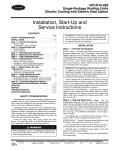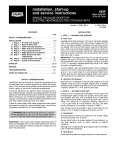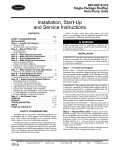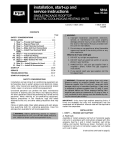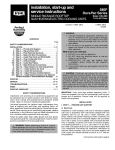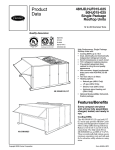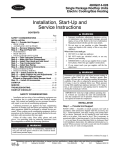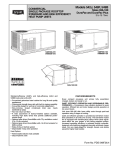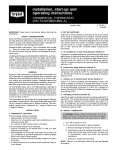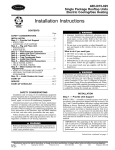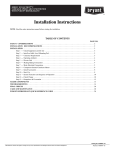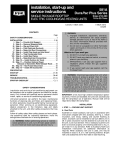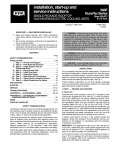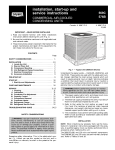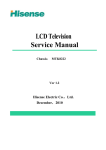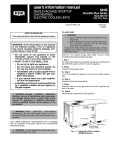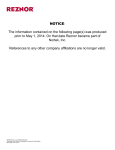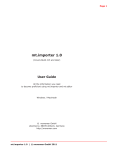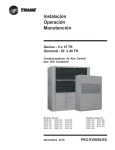Download Bryant 551a User's Manual
Transcript
installation, start-up and service instructions 551A DuraPac Plus Series Sizes 155-240 SINGLE PACKAGE ROOFTOP ELECTRIC COOLING/ELECTRIC HEATING UNITS Cancels: II 551A-155-2 II 551A-155-3 3/1/01 INSTALLATION CONTENTS Page I. STEP 1 — PROVIDE UNIT SUPPORT SAFETY CONSIDERATIONS . . . . . . . . . . . . . . . . . . . . . . . . . 1 A. Roof Curb INSTALLATION . . . . . . . . . . . . . . . . . . . . . . . . . . . . . . . . . .1-17 I. Step 1 — Provide Unit Support. . . . . . . . . . . . . . . . . 1 II. Step 2 — Rig and Place Unit . . . . . . . . . . . . . . . . . . . 1 III. Step 3 — Field Fabricate Ductwork . . . . . . . . . . . . . 7 IV. Step 4 — Make Unit Duct Connections . . . . . . . . . . .7 V. Step 5 — Trap Condensate Drain . . . . . . . . . . . . . . . 7 VI. Step 6 — Make Electrical Connections. . . . . . . . . . . . 8 VII. Step 7 — Make Outdoor-Air Inlet Adjustments . . . . . . . . . . . . . . . . . . . . . . . . . . . . . . 11 VIII. Step 8 — Install Outdoor-Air Hood. . . . . . . . . . . . . 12 IX. Step 9 — Install All Accessories . . . . . . . . . . . . . . 15 X. Step 10 — Install Humidistat for Optional Perfect Humidity™ Dehumidification Package . . 16 START-UP . . . . . . . . . . . . . . . . . . . . . . . . . . . . . . . . . . . . .18-25 Assemble and install accessory roof curb or horizontal supply roof curb in accordance with instructions shipped with the accessory. Accessory roof curb and horizontal supply roof curb and information required to field fabricate a roof curb or horizontal supply roof curb are shown in Fig. 1 and 2. Install insulation, cant strips, roofing, and counter flashing as shown. Ductwork can be secured to roof curb before unit is set in place. SERVICE . . . . . . . . . . . . . . . . . . . . . . . . . . . . . . . . . . . . . .26-32 TROUBLESHOOTING. . . . . . . . . . . . . . . . . . . . . . . . . . . . 33,34 START-UP CHECKLIST . . . . . . . . . . . . . . . . . . . . . . . . . . CL-1 SAFETY CONSIDERATIONS Installation and servicing of air-conditioning equipment can be hazardous due to system pressure and electrical components. Only trained and qualified service personnel should install, repair, or service air-conditioning equipment. Untrained personnel can perform basic maintenance functions of cleaning coils and filters and replacing filters. All other operations should be performed by trained service personnel. When working on air-conditioning equipment, observe precautions in the literature, tags and labels attached to the unit, and other safety precautions that may apply. Follow all safety codes. Wear safety glasses and work gloves. Use quenching cloth for unbrazing operations. Have fire extinguishers available for all brazing operations. WARNING: Before performing service or maintenance operations on unit, turn off main power switch to unit. Electrical shock could cause personal injury. IMPORTANT: Units have high ambient operating limits. If limits are exceeded, the unit will automatically lock the compressor out of operation. Manual reset will be required to restart the compressor. IMPORTANT: The gasketing of the unit to the roof curb or horizontal supply roof curb is critical for a leakproof seal. Install gasket supplied with the roof curb or horizontal supply roof curb as shown in Fig. 1. Improperly applied gasket can result in air leaks and poor unit performance. Roof curb must be level. This is necessary to permit unit drain to function properly. Unit leveling tolerance is ± 1/16 in. per linear ft in any direction. Refer to Accessory Roof Curb or Horizontal Supply Roof Curb Installation Instructions for additional information as required. B. Alternate Unit Support When the curb or adapter cannot be used, support unit with sleepers using unit curb or adapter support area. If sleepers cannot be used, support long sides of unit with a minimum of 3 equally spaced 4-in. x 4-in. pads on each side. II. STEP 2 — RIG AND PLACE UNIT Inspect unit for transportation damage. File any claim with transportation agency. Keep unit upright, and do not drop. Use spreader bars over unit to prevent sling or cable damage. Rollers may be used to move unit across a roof. Level by using unit frame as a reference; leveling tolerance is ± 1/16 in. per linear ft in any direction. See Fig. 3 for additional information. Unit weight is shown in Table 1. Four lifting holes are provided in ends of unit base rails as shown in Fig. 3. Refer to rigging instructions on unit. A. Positioning Provide clearance around and above unit for airflow, safety, and service access (Fig. 4 and 5). Do not install unit in an indoor location. Do not locate air inlets near exhaust vents or other sources of contaminated air. Although unit is weatherproof, guard against water from higher level runoff and overhangs. B. Roof Mount Check building codes for weight distribution requirements. —2 — CURB HEIGHT DESCRIPTION 1′-2″ Standard Curb CRRFCURB010A00 (305) 14″ High Curb 2′-0″ Standard CRRFCURB011A00 for Units Requiring (610) High Installation Side Supply and 2′-0″ Return Curb for CRRFCURB012A00 (610) High Installation 2′-0″ High-Static CRRFCURB013A00 (610) Transition Duct PKG. NO. REF. Fig. 1 — Roof Curb Details Direction of airflow. ALL UNIT Deg. .28 A in. .45 Deg. .28 B DIMENSIONS* (DEGREES AND INCHES) in. .43 5. Roof curb: 16 ga. (VA03-56) stl. 6. A 90 degree elbow must be installed on the supply ductwork below the unit discharge for units equipped with electric heaters. NOTE: To prevent the hazard of stagnant water build-up in the drain pan of the indoor section, unit can only be pitched as shown. 4. NOTES: 1. Roof curb accessory is shipped disassembled. 2. Insulated panels: 1″ thick neoprene coated 11/2 lb density. 3. Dimensions in ( ) are in millimeters. UNIT 551A NOTE: For preassembled horizontal adapter roof curb part no. CRRFCURB013A00, the accessory kit includes a factory-designed, high-static, regain transition duct. For horizontal curb part no. CRRFCURB012A00, a field-supplied transition duct is required. Fig. 2 — Horizontal Supply Roof Curb and Horizontal Adapter Roof Curb 155 180 240 MAXIMUM SHIPPING WEIGHT lb 1625 1700 1800 kg 737 771 816 DIMENSIONS A B ft-in. mm ft-in. mm 6-111/2 2121 4- 0 1219 6-111/2 2121 3-10 1168 6-111/2 2121 3- 7 1092 NOTES: 1. Dimensions in ( ) are in millimeters. 2. Refer to Fig. 4 and 5 for unit operating weights. 3. Remove boards at ends of unit and runners prior to rigging. 4. Rig by inserting hooks into unit base rails as shown. Use corner post from packaging to protect coil from damage. Use bumper boards for spreader bars. 5. Weights do not include optional EconoMi$er. Add 80 lb (36 kg) for EconoMi$er weight. 6. Weights given are for aluminum evaporator and condenser coil plate fins. Weights include electric heat. 7. Add 75 lb (34 kg) for crating on 551A155 and 180 units. Add 135 lb (61 kg) for crating on 551A240 units. 8. Add 150 lb (68 kg) for copper condenser coil. Add 280 lb (127 kg) for copper condenser and evaporator coils. CAUTION: All panels must be in place when rigging. Fig. 3 — Rigging Details —3 — —4 — Direction of airflow. 4. 5. Ductwork to be attached to accessory roof curb only. 6. Minimum clearance: • Rear: 7′-0″ (2134) for coil removal. This dimension can be reduced to 4′-0″ (1219) if conditions permit coil removal from the top. • Left side: 4′-0″ (1219) for proper condenser coil airflow. • Front: 4′-0″ (1219) for control box access. • Right side: 4′-0″ (1219) for proper operation of damper and power exhaust if so equipped. • Top: 6′-0″ (1829) to assure proper condenser fan operation. • Local codes or jurisdiction may prevail. 7. With the exception of clearance for the condenser coil and the damper/ power exhaust as stated in Note #6, a removable fence or barricade requires no clearance. 8. Dimensions are from outside of corner post. Allow 0′-5/16 ″ (8) on each side for top cover drip edge. 9. See drawing 50TJ500352 for service option details. 10. A 90 degree elbow must be installed on the supply ductwork below the unit discharge for units equipped with electric heaters. Center of Gravity. 3. NOTES: 1. Refer to print for roof curb accessory dimensions. 2. Dimensions in ( ) are in millimeters. STD UNIT ECONOMI$ER CORNER CORNER CORNER CORNER DIM A DIM B DIM C WEIGHT WEIGHT A B C D Lb Kg Lb Kg Lb Kg Lb Kg Lb Kg Lb Kg ft-in. mm ft-in. mm ft-in. mm 1575 714 80 36.3 407 185 375 170 383 174 410 186 3-5 1039 3-5 1054 1-10 559 1650 748 80 36.3 375 170 375 170 449 204 452 205 3-2 963 3-7 1092 1-10 559 Fig. 4 — Base Unit Dimensions, 551A155 and 180 155 180 UNIT 551A —5 — Direction of airflow. 4. 5. Ductwork to be attached to accessory roof curb only. 6. Minimum clearance: • Rear: 7′-0″ (2134) for coil removal. This dimension can be reduced to 4′-0″ (1219) if conditions permit coil removal from the top. • Left side: 4′-0″ (1219) for proper condenser coil airflow. • Front: 4′-0″ (1219) for control box access. • Right side: 4′-0″ (1219) for proper operation of damper and power exhaust if so equipped. • Top: 6′-0″ (1829) to assure proper condenser fan operation. • Local codes or jurisdiction may prevail. 7. With the exception of clearance for the condenser coil and the damper/ power exhaust as stated in Note #6, a removable fence or barricade requires no clearance. 8. Dimensions are from outside of corner post. Allow 0′-5/16 ″ (8) on each side for top cover drip edge. 9. See drawing 50TJ500352 for service option details. 10. A 90 degree elbow must be installed on the supply ductwork below the unit discharge for units equipped with electric heaters. Center of Gravity. 3. DIM C ft-in. mm ft-in. mm 3-5 1054 1-8 508 DIM B NOTES: 1. Refer to print for roof curb accessory dimensions. 2. Dimensions in ( ) are in millimeters. STD UNIT ECONOMI$ER CORNER CORNER CORNER CORNER DIM A WEIGHT WEIGHT A B C D Lb Kg Lb Kg Lb Kg Lb Kg Lb Kg Lb Kg ft-in. mm 1750 794 80 36.3 420 191 395 179 448 203 486 221 3-3 988 Fig. 5 — Base Unit Dimensions, 551A240 240 UNIT 551A Table 1 — Physical Data UNIT 551A NOMINAL CAPACITY (tons) OPERATING WEIGHT (lb) Unit Al/Al* Al/Cu* Cu/Cu* EconoMi$er Roof Curb† Perfect Humidity™ Dehumidification Package COMPRESSOR Quantity...Model (Ckt 1, Ckt 2) Number of Refrigerant Circuits Crankcase Heater Watts Loading (% of Full Capacity) Oil (oz) (Ckt 1, Ckt 2) REFRIGERANT TYPE Expansion Device Operating Charge (lb)** Circuit 1 Circuit 2 CONDENSER COIL Rows...Fins/in. Total Face Area (sq ft) CONDENSER FAN Nominal Cfm Quantity...Diameter (in.) Motor Hp...Rpm Watts Input (Total) EVAPORATOR COIL Rows...Fins/in. Total Face Area (sq ft) EVAPORATOR FAN Quantity...Size (in.) Type Drive Nominal Cfm Std Motor Hp Opt Motor Hp Motor Nominal Rpm Std Maximum Continuous Bhp Opt Maximum Continuous Bhp Motor Frame Size Fan Rpm Range Motor Bearing Type Maximum Allowable Rpm Motor Pulley Pitch Dia. Nominal Motor Shaft Diameter (in.) Fan Pulley Pitch Diameter (in.) Nominal Fan Shaft Diameter (in.) Belt, Quantity...Type...Length (in.) Pulley Center Line Distance (in.) Speed Change per Full Turn of Movable Pulley Flange (Rpm) Movable Pulley Maximum Full Turns From Closed Position Factory Speed Factory Speed Setting (Rpm) Low-Medium Static High Static Low-Medium Static High Static Low-Medium Static High Static Low-Medium Static High Static Low-Medium Static High Static Low-Medium Static High Static 155 180 240 12 15 20 1575 1725 1855 80 200 40 1650 1800 1930 80 200 40 1750 1900 2030 80 200 40 1...ZR72KC, 1...ZR57KC 2 70 0, 56, 100 60, 66 1...ZR94KC, 1...ZR72KC 2 70 0, 60, 100 85, 60 R-22 TXV 1...ZR125KC, 1...ZR108KC 2 70 0, 60, 100 110, 110 20.7 19.5 18.5 11.9 13.45 13.3 3 Cross-Hatched /8-in. Copper Tubes, Aluminum Lanced, Aluminum Pre-Coated, or Copper Plate Fins 4...15 4...15 4...15 21.7 21.7 21.7 Propeller Type 10,500 10,500 14,200 3...22 3...22 2...30 1/ ...1050 1/ ...1050 1...1075 2 2 1100 1100 3400 Cross-Hatched 3/8-in. Copper Tubes, Aluminum Lanced or Copper Plate Fins, Face Split 4...15 4...15 4...15 17.5 17.5 17.5 Centrifugal Type 2...10 x 10 2...12 x 12 2...12 x 12 Belt Belt Belt 5200 6000 8000 2.9 5 7.5 3.7 1725 1745 1745 3.13 6.13 9.47 [208 v], 10.33 [230 v and 460 v] 4.38 N/A N/A 56H 184T 213T 834-1064 873-1021 1002 -1151 1161-1426 1025-1200 1193-1369 Ball Ball Ball 1,550 1,550 1,550 3.1/4.1 4.9/5.9 5.4/6.6 3.7/4.7 4.9/5.9 5.4/6.6 7/ 11/8 13/8 8 6.0 9.4 9.4 5.2 8.0 7.9 17/16 17/16 13/16 1...BX...42 1...BX...50 1...BX...54 1...BX...42 1...BX...48 1...BX...50 13.5-15.5 13.3-14.8 14.6-15.4 58 37 37 67 44 44 4†† 3.5 978 1327 HIGH-PRESSURE SWITCH (psig) Cutout Reset (Auto.) LOW-PRESSURE SWITCH (psig) Cutout Reset (Auto.) FREEZE PROTECTION THERMOSTAT (F) Opens Closes OUTDOOR-AIR INLET SCREENS 27 44 30 ± 5 45 ± 5 Cleanable 2...20 x 25 x 1 1...20 x 20 x 1 Throwaway 4...20 x 20 x 2 4...16 x 20 x 2 Quantity...Size (in.) Quantity...Size (in.) LEGEND — Aluminum — Brake Horsepower — Copper — Thermostatic Expansion Valve 4†† 3.5 1095 1303 426 320 RETURN-AIR FILTERS Al Bhp Cu TXV 4†† 3.5 965 1134 **Circuit 1 uses the lower portion of condenser coil and lower portion of evaporator coils, and Circuit 2 uses the upper portion of both coils. ††Due to belt and pulley style, pulley cannot be set from 0 to 11/2 turns open. *Evaporator coil fin material/condenser coil fin material. †Weight of 14-in. roof curb. —6 — III. STEP 3 — FIELD FABRICATE DUCTWORK Secure all ducts to building structure. Use flexible duct connectors between unit and ducts as required. Insulate and weatherproof all external ductwork, joints, and roof openings with counter flashing and mastic in accordance with applicable codes. Ducts passing through an unconditioned space must be insulated and covered with a vapor barrier. The 551A units with electric heat require a 1-in. clearance for the first 24 in. of ductwork. Outlet grilles must not lie directly below unit discharge. NOTE: A 90-degree elbow must be provided in the ductwork to comply with UL (Underwriters’ Laboratories) codes for use with electric heat. WARNING: For vertical supply and return units, tools or parts could drop into ductwork and cause an injury. Install a 90 degree turn in the return ductwork between the unit and the conditioned space. If a 90 degree elbow cannot be installed, then a grille of sufficient strength and density should be installed to prevent objects from falling into the conditioned space. Due to electric heater, supply duct will require 90 degree elbow. IV. STEP 4 — MAKE UNIT DUCT CONNECTIONS Unit is shipped for thru-the-bottom duct connections. Ductwork openings are shown in Fig. 6. Field-fabricated concentric ductwork may be connected as shown in Fig. 7 and 8. Attach all ductwork to roof curb and roof curb basepans. Refer to installation instructions shipped with accessory roof curb for more information. V. STEP 5 — TRAP CONDENSATE DRAIN See Fig. 4, 5, and 9 for drain location. Plug is provided in drain hole and must be removed when unit is operating. One 3/ -in. half-coupling is provided inside unit evaporator sec4 tion for condensate drain connection. An 81/2 in. x 3/4-in. diameter nipple and a 2-in. x 3/4-in. diameter pipe nipple are coupled to standard 3/4-in. diameter elbows to provide a straight path down through holes in unit base rails (see Fig. 10). A trap at least 4-in. deep must be used. Shaded area indicates block-off panels. NOTE: Dimension A, A′ and B, B′ are obtained from field-supplied ceiling diffuser. CAUTION: Concentric ducts may only be installed on units without electric heat. Personal injury or unit damage may result. NOTE: Do not drill in this area, as damage to basepan may result in water leak. Fig. 8 — Concentric Duct Details Fig. 6 — Air Distribution — Thru-the-Bottom (551A180 and 240 Shown) INDOOR FAN MOTOR ACCESS FILTER ACCESS NOTE: Do not drill in this area, as damage to basepan may result in water leak. 3/4" FPT DRAIN CONNECTION Fig. 7 — Concentric Duct Air Distribution (551A180 and 240 Shown) Fig. 9 — Condensate Drain Details (551A155 Shown) —7 — 1-3/8" DRAIN HOLE IMPORTANT: If the supply voltage phase imbalance is more than 2%, contact your local electric utility company immediately. Unit failure as a result of operation on improper line voltage or excessive phase imbalance constitutes abuse and may cause damage to electrical components. Fig. 10 — Condensate Drain Piping Details VI. STEP 6 — MAKE ELECTRICAL CONNECTIONS A. Field Power Supply Unit is factory wired for voltage shown on nameplate. When installing units, provide a disconnect, per NEC (National Electrical Code) requirements, of adequate size (Table 2). Electrical heater data is shown in Table 3. All field wiring must comply with NEC and local requirements. Route power lines through control box access panel or unit basepan (Fig. 4 and 5) to connections as shown on unit wiring diagram and Fig. 11. B. Field Control Wiring Install a Bryant-approved accessory thermostat assembly according to the installation instructions included with the accessory. Locate thermostat assembly on a solid wall in the conditioned space to sense average temperature. Route thermostat cable or equivalent single leads of colored wire from subbase terminals through conduit in unit to lowvoltage connections as shown on unit label wiring diagram and in Fig. 12. NOTE: For wire runs up to 50 ft, use no. 18 AWG (American Wire Gage) insulated wire (35 C minimum). For 50 to 75 ft, use no. 16 AWG insulated wire (35 C minimum). For over 75 ft, use no. 14 AWG insulated wire (35 C minimum). All wire larger than no. 18 AWG cannot be directly connected to the thermostat and will require a junction box and splice at the thermostat. Set heat anticipator settings as indicated in Table 4. Settings may be changed slightly to provide a greater degree of comfort for a particular installation. Operating voltage to compressor must be within voltage range indicated on unit nameplate. On 3-phase units, voltages between phases must be balanced within 2% and the current must be balanced within 10%. CAUTION: The correct power phasing is critical in the operation of the scroll compressors. An incorrect phasing will cause the compressor to rotate in the wrong direction. This may lead to premature compressor failure. Use the following formula to determine the percentage of voltage imbalance. Percentage of Voltage Imbalance max voltage deviation from average voltage average voltage TB1 MAXIMUM WIRE SIZE EXAMPLE: Supply voltage is 460-3-60. AB = 452 v BC = 464 v AC = 455 v 455 + 464 + 455 3 EQUIP — Equipment GND — Ground kcmil — Thousand Circular Mils 1371 3 LEGEND NEC — National Electrical Code TB — Terminal Block Fig. 11 — Field Power Wiring Connections = 457 Determine maximum deviation from average voltage: (AB) 457 – 452 = 5 v (BC) 464 – 457 = 7 v (AC) 457 – 455 = 2 v THERMOSTAT ASSEMBLY REMOVABLE JUMPER Y2 W1 W2 G C Y1 Y2 W1 W2 G C X BRN WHT 7 457 UNIT LOW-VOLTAGE CONNECTIONS = 1.53% This amount of phase imbalance is satisfactory as it is below the maximum allowable 2%. —8 — L Y1 BLK RED R RC VIO RH Maximum deviation is 7 v. Determine percent voltage imbalance: Percentage of Voltage Imbalance = 100 x 460 2/0 ORN = All PNK Average Voltage = VOLTAGE 208/230 350 kcmil UNIT 551A BLU = 100 x Fig. 12 — Field Control Thermostat Wiring X Table 2 — Electrical Data UNIT 551A NOMINAL VOLTAGE (3 Ph, 60 Hz) VOLTAGE RANGE Min Max COMPRESSOR No. 1 No. 2 RLA LRA RLA LRA OFM Qty Hp IFM FLA (ea) Hp FLA 208/230 187 253 20.7 156 19.3 123 3 0.5 1.7 2.9 8.8/ 8.4 460 414 508 10 70 10 62 3 0.5 0.8 2.9 4.2 208/230 187 253 20.7 156 19.3 123 3 0.5 1.7 3.7 11.0/ 10.5 460 414 508 10 70 10 62 3 0.5 0.8 3.7 4.8 208/230 187 253 32.1 195 20.7 156 3 0.5 1.7 5.0 15.8/ 15.8 460 414 508 16.4 95 10 70 3 0.5 0.8 5.0 7.9 208/230 187 253 42 239 33.6 225 2 1 6.6 7.5 25.0/ 25.0 460 414 508 19.2 125 17.3 114 2 1 3.3 7.5 13.0 155 (Standard IFM) 155 (Optional IFM) 180 240 POWER EXHAUST ELECTRIC HEAT* POWER SUPPLY FLA LRA kW FLA MCA MOCP† — 4.6 — 4.6 — 4.6 — 4.6 — 2.3 — 2.3 — 2.3 — 2.3 — 4.6 — 4.6 — 4.6 — 4.6 — 2.3 — 2.3 — 2.3 — 2.3 — 4.6 — 4.6 — 4.6 — 4.6 — 2.3 — 2.3 — 2.3 — 2.3 — 4.6 — 4.6 — 4.6 — 4.6 — 2.3 — 2.3 — 2.3 — 2.3 — 18.8 — 18.8 — 18.8 — 18.8 — 6.0 — 6.0 — 6.0 — 6.0 — 18.8 — 18.8 — 18.8 — 18.8 — 6.0 — 6.0 — 6.0 — 6.0 — 18.8 — 18.8 — 18.8 — 18.8 — 6.0 — 6.0 — 6.0 — 6.0 — 18.8 — 18.8 — 18.8 — 18.8 — 6.0 — 6.0 — 6.0 — 6.0 — — 14/19 14/19 26/34 26/34 42/56** 42/56** — — 15 15 32 32 55** 55** — — 14/19 14/19 26/34 26/34 42/56** 42/56** — — 15 15 32 32 55** 55** — — 26/34 26/34 42/56 42/56 56/75** 56/75** — — 32 32 55 55 80** 80** — — 26/34 26/34 42/56 42/56 56/75** 56/75** — — 32 32 55 55 80** 80** — — 39/ 45 39/ 45 71/ 82 71/ 82 117/135 117/135 — — 18 18 39 39 66 66 — — 39/ 45 39/ 45 71/ 82 71/ 82 117/135 117/135 — — 18 18 39 39 66 66 — — 71/ 82 71/ 82 117/135 117/135 156/180 156/180 — — 39 39 66 66 96 96 — — 71/ 82 71/ 82 117/135 117/135 156/180 156/180 — — 39 39 66 66 96 96 59/ 59 64/ 63 60/ 67 66/ 73 100/113 106/119 157/146 163/151 29 31 29 31 54 57 71 74 61/ 61 65/ 66 62/ 70 68/ 76 102/116 108/122 159/149 165/155 30 32 30 32 55 58 72 75 82/ 82 86/ 86 109/122 114/128 166/155 172/161 176/200 182/206 41 43 59 62 76 79 106 109 124/124 129/129 124/134 129/140 178/166 183/172 187/211 193/217 61 63 65 68 82 85 112 115 70/ 70 80/ 80 70/ 70 80/ 80 100/125 110/125 175/175 175/175 35 40 35 40 60 60 80 80 80/ 80 80/ 80 80/ 80 80/ 80 110/125 110/125 175/175 175/175 35 40 35 40 60 60 80 80 110/110 110/110 110/125 125/150 175/175 175/175 200/225 200/225 50 50 60 70 90 90 125 125 150/150 150/150 150/150 150/150 200/175 200/175 200/225 200/225 80 80 80 80 90 90 125 125 (See Legend on page 10.) —9 — FLA — HACR — IFM — LRA — MCA — MOCP— NEC — OFM — RLA — LEGEND Full Load Amps Heating, Air Conditioning and Refrigeration Indoor (Evaporator) Fan Motor Locked Rotor Amps Minimum Circuit Amps Maximum Overcurrent Protection National Electrical Code Outdoor (Condenser) Fan Motor Rated Load Amps Example: Supply voltage is 460-3-60. AB = 452 v BC = 464 v AC = 455 v Average Voltage = = *Heater capacity (kW) is based on heater voltage of 208 v, 240 v, and 480 v. Heaters are rated at 240 v, or 480 v. If power distribution voltage to unit varies from rated heater voltage, heater kW will vary accordingly. †Fuse or HACR circuit breaker. **Heaters are field installed only. NOTES: 1. In compliance with NEC requirements for multimotor and combination load equipment (refer to NEC Articles 430 and 440), the overcurrent protective device for the unit shall be fuse or HACR breaker. Canadian units may be fuse or circuit breaker. 2. Unbalanced 3-Phase Supply Voltage Never operate a motor where a phase imbalance in supply voltage is greater than 2%. Use the following formula to determine the percent of voltage imbalance. % Voltage Imbalance max voltage deviation from average voltage = 100 x average voltage 452 + 464 + 455 3 1371 3 = 457 Determine maximum deviation from average voltage. (AB) 457 – 452 = 5 v (BC) 464 – 457 = 7 v (AC) 457 – 455 = 2 v Maximum deviation is 7 v. Determine percent of voltage imbalance. 7 % Voltage Imbalance = 100 x 457 = 1.53% This amount of phase imbalance is satisfactory as it is below the maximum allowable 2%. IMPORTANT: If the supply voltage phase imbalance is more than 2%, contact your local electric utility company immediately. 3. MCA calculation for units with electric heaters over 50 kW = (1.25 x IFM amps) + (1.00 x heater FLA). Table 3 — Electric Resistance Heater Data UNIT 551A 155 180 240 208 14 26 42 26 42 56 26 42 56 HEATER kW Unit Voltages 230 240 460 17 19 14 31 34 30 52 56 50 31 34 30 52 56 50 69 75 73 31 34 30 52 56 50 69 75 73 480 15 32 55 32 55 80 32 55 80 HEATER STAGES % HEAT PER STAGE MAXIMUM STAGES* 1 2 2 2 2 2 2 2 2 100 50/50 33/67 50/50 33/67 50/50 50/50 33/67 50/50 1 2 3 2 3 4 2 3 4 MINIMUM Heating Cfm Cfm L/s 3750 1770 3750 1770 5000 2360 HEATER AMPS 208 39.3 71.3 117.0 71.3 117.0 155.9 71.3 117.0 155.9 *Maximum number of stages using accessory low-ambient kit or head pressure control device and low-ambient kit. NOTE: Heaters are rated at 240, and 480 v. —10— 230 43.4 78.9 129.4 78.8 129.4 172.4 78.8 129.4 172.4 240 45.3 82.3 135.0 82.3 135.0 179.9 82.3 135.0 179.9 460 17.2 37.3 63.3 37.3 63.3 92.0 37.3 63.3 92.0 480 17.9 39.0 66.1 39.0 66.1 96.0 39.0 66.1 96.0 C. Optional Non-Fused Disconnect On units with the optional non-fused disconnect, incoming power will be wired into the disconnect switch. Refer to Fig. 13 for wiring for 100 and 200 amp disconnect switches. Units with an MOCP (maximum overcurrent protection) under 100 will use the 100 amp disconnect switch. Units with an MOCP over 100 will use the 200 amp disconnect switch. Refer to the applicable disconnect wiring diagram. To prevent breakage during shipping, the disconnect handle and shaft are shipped and packaged inside the unit control box. Install the disconnect handle before unit operation. To install the handle and shaft, perform the following procedure: 1. Open the control box door and remove the handle and shaft from shipping location. 2. Loosen the Allen bolt located on the disconnect switch. The bolt is located on the square hole and is used to hold the shaft in place. The shaft cannot be inserted until the Allen bolt is moved. 3. Insert the disconnect shaft into the square hole on the disconnect switch. The end of the shaft is specially cut and the shaft can only be inserted in the correct orientation. 4. Tighten the Allen bolt to lock the shaft into position. VII. STEP 7 — MAKE OUTDOOR-AIR INLET ADJUSTMENTS A. Manual Outdoor-Air Damper All units (except those equipped with a factory-installed economizer) have a manual outdoor-air damper to provide ventilation air. Damper can be preset to admit up to 25% outdoor air into return-air compartment. To adjust, loosen securing screws and move damper to desired setting. Then retighten screws to secure damper (Fig. 14). B. Optional EconoMi$er EconoMi$er Motor Control Module (Fig. 15-17) Set the ECONSP dial to the ‘‘D’’ setting (Fig. 16). The control module is located on the EconoMi$er motor. See Fig. 15 and 17. Damper Vent Position Setting 1. Set fan switch at ON position (continuous fan operation) and close night switch if used. 2. Set system selector switch to OFF position. 3. Turn Min Pos (%) dial slowly until dampers assume desired vent position. Do not manually operate EconoMi$er motor since damage to motor will result. 5. Close the control box door. 6. Attach the handle to the external access door with the two screws provided. When the handle is in the ON position, the handle will be vertical. When the handle is in the OFF position, the handle will be horizontal. 7. Turn the handle to the OFF position and close the door. The handle should fit over the end of the shaft when the door is closed. 8. The handle must be in the OFF position to open the control box door. D. Optional Convenience Outlet On units with optional convenience outlet, a 115-v GFI (ground fault interrupt) convenience outlet receptacle is provided for field wiring. Field wiring should be run through the 7/ -in. knockout provided in the basepan near the return air 8 opening. Fig. 14 — 25% Outdoor-Air Section Details 6T3 4T2 2T1 LOAD CONTROL MODULE 5L3 3L2 1L1 LINE ACTUATOR ECONOMI$ER NOTE: The disconnect takes the place of TB-1 as shown on the unit wiring diagram label and the component arrangement label. Fig. 13 — Optional Non-Fused Disconnect Wiring —11— Fig. 15 — EconoMi$er Damper Assembly — End View 6. Match notches in hood top panel to unit top panel screws. Insert hood flange between unit top panel flange and unit. Tighten screws. 7. Hold hood side panel flanges flat against unit, and install screws removed in Step 5. 8. Insert outdoor-air inlet screens and spacer in channel created by lower filter retainer and filter support bracket. Table 4 — Heat Anticipator Settings UNIT 551A UNIT VOLTAGES 208/230-3-60 155-240 460-3-60 kW* STAGE 1 STAGE 2 14/19 26/34 42/56 56/75 32 55 80 .40 .40 .66 .66 .40 .40 .66 — .66 .40 .66 .40 .66 .66 9. Attach remaining short section of filter support bracket. *Heater kW is based on heater voltage of 208 v, 240 v, or 480 v. A. Outdoor Air Enthalpy Sensor Installation Perform the following procedure to install the outdoor air enthalpy sensor (part no. CROUTENT001A00). 1. Remove the outdoor air temperature sensor cover. See Fig. 21. Save cover and screws. 2. Disconnect the wiring from the installed outdoor air temperature sensor. See Fig. 22. 3. Use a 1/4-in. nut driver to remove the 2 screws securing the outdoor air temperature sensor to the sheet metal. Fig. 16 — EconoMi$er Control Module Adjustment Potentiometers 4. Mount the outdoor air enthalpy sensor in the outdoor air temperature sensor location using the screws removed in Step 3. 5. Connect the outdoor air enthalpy sensor wiring harness to the EconoMi$er control module and sensor. 6. Re-install sensor cover saved from Step 1. B. Return Air Temperature Sensor or Return Air Enthalpy Sensor Installation Perform the following procedure to install the return air temperature sensor (part no. CRRETTMP001A00) or return air enthalpy sensor (part no. CRRETENT001A00). 1. Attach the sensor to the mounting bracket using 2 self-tapping 1/2-in. screws provided. CONTROL MODULE 2. Mount the bracket to the inside of the return air opening flange using a 1/4-in. nut driver and 2 no. 6 sheet metal screws. NOTE: The sensor must be mounted in an upright position. ACTUATOR Fig. 17 — EconoMi$er Control Module Location 3. Feed the sensor wiring through the bushing in EconoMi$er to secure wires. VIII. STEP 8 — INSTALL OUTDOOR-AIR HOOD The same type of factory-installed hood is used on units with 25% air ventilation and units with an EconoMi$er. NOTE: The hood top panel, upper and lower filter retainers, hood drain pan, baffle (180-240), and filter support bracket are secured opposite the condenser end of the unit. The screens, hood side panels, remaining section of filter support bracket, seal strip, and all other hardware are in a package located inside the return-air filter access panel (Fig. 18). 4. Route sensor wiring harness from sensor to EconoMi$er control module. Secure wiring harness to the original harness using tie wraps. 5. Wire the sensor to the EconoMi$er control module. See Fig. 23 and 24. 1. Attach seal strip to upper filter retainer. See Fig. 19. 2. Assemble hood top panel and side panels, upper filter retainer, and hood drain pan (Fig. 20). 3. Secure lower filter retainer and long section of filter support bracket to unit. See Fig. 20. Leave screws loose on size 180 and 240 units. 4. Slide baffle (size 180 and 240 units) behind lower filter retainer and tighten screws. 5. Loosen sheet metal screws for base unit top panel located above outdoor-air inlet opening, and remove screws for hood side panels located on the sides of the outdoor-air inlet opening. Fig. 18 — Outdoor-Air Hood Component Location —12— OUTSIDE AIR SENSOR SENSOR COVER Fig. 19 — Seal Strip Location (Air Hood Cross-Sectional View) BAFFLE (180 AND 240 ONLY) Fig. 21 — Outdoor-Air Sensor Location MOUNTING SCREW LOWER FILTER RETAINER FILTER SUPPORT BRACKET SENSOR WIRING CONNECTIONS HOOD TOP PANEL MOUNTING SCREW HOOD SIDE PANELS (2) BAFFLE (180 AND 240 ONLY) WIRING HARNESS Fig. 22 — Outdoor-Air Sensor Details LOWER FILTER RETAINER Refer to Table 5 to determine the sensors required for each strategy. Differential Enthalpy Switchover Strategy FILTER SUPPORT BRACKET The differential enthalpy switchover strategy must be selected manually, if required. To enable, press and hold the CONFIG button for 30 seconds, then release. The LED will flash twice to indicate the change of configuration. HOOD DRAIN PAN UPPER FILTER RETAINER NOTE: The outdoor-air hood comes with a baffle which is used on 180 and 240 units only; discard baffle for 155 units. To return to single enthalpy mode, press and hold the CONFIG button for 30 seconds. The LED will flash once to indicate the change of configuration. Fig. 20 — Outdoor-Air Hood Details C. Commissioning The EconoMi$er saves energy when it uses outdoor air to provide free cooling instead of mechanical air conditioning. The EconoMi$er switchover strategy determines if the outdoor air is suitable for free cooling. The EconoMi$er chooses the switchover strategy with the most energy savings, provided that the required sensors are connected and functioning normally. IMPORTANT: If a sensor stops functioning normally (becomes unreliable), the EconoMi$er switches to the next best strategy. D. Discharge Air Thermistor (DAT) The discharge air thermistor is factory-mounted on the supply-fan housing in the fan section of the unit. The DAT is factory-wired to the EconoMi$er Control Module. E. CO2 Control Setup If a CO2 sensor is not being used, proceed to the next section. If a CO2 sensor is being used, perform the following: 1. Determine the value at which you want the minimum position of the dampers to begin opening to allow a greater amount of outdoor air to enter. The range is 800 to 1,400 ppm. 2. Locate the CO2 SP (PPM) potentiometer and adjust to the desired set point. See Fig. 16. —13— F. Mechanical Cooling Lockout Determine the outdoor-air temperature at which you want the mechanical cooling (compressors) to be disabled. Locate the mechanical cooling lockout (MECH CLG LOCKOUT) potentiometer. To disable this feature, turn the potentiometer counterclockwise (CCW) to the OFF position. Otherwise, set the value between 10 and 60 F. Mechanical cooling will not operate when the outdoor air temperature is below this value. See Fig. 16. G. Dry Bulb Changeover Set Up Determine the dry bulb changeover set point from Table 6. The settings are A, B, C and D. Locate the ECON SP potentiometer and set the dry bulb changeover set point. See Fig. 16. When the OAT is above this set point, the damper is limited to minimum position setting. If a potentiometer fails, its setting will default to the values in Table 7. Table 5 — EconoMi$er Switchover Control Strategy ECONOMI$ER SWITCHOVER STRATEGY Outdoor Air Temperature Dry Bulb SENSORS REQUIRED Outdoor Air Enthalpy Return Air Temperature Return Air Enthalpy X Single Enthalpy X Differential Temperature X X Differential Enthalpy* X X *Must be selected manually. Table 6 — Changeover Set Points SETTINGS Dry Bulb (°F) Single Enthalpy* (Btu/lb) Differential Temperature* (°F, Not Adjustable) Differential Enthalpy* (Btu/lb, Not Adjustable) Table 7 — Default Potentiometer Settings A 73 27 B 69 25 C 66 24 D 63 22 2 2 2 2 1 1 1 1 POTENTIOMETER CO2 SP (PPM) MECH CLG LOCKOUT ECON SP MIN POS (%) *Field-installed accessory. COM DAT DM GND OAH OAT POT RAH RAT REM — — — — — — — — — — LEGEND Common Discharge Air Thermistor Damper Motor Ground Outdoor-Air Enthalpy Sensor Outdoor-Air Temperature Sensor Potentiometer Return-Air Enthalpy Sensor Return-Air Temperature Sensor Remote *OAT sensor shipped with economizer option. OAH, RAT, RAH and CO2 are field-installed accessories. Fig. 23 — Typical EconoMi$er Wiring —14— DEFAULT SETTING 1,000 50 F D 20 H. Ventilation Air (Minimum Position Set Up) If ventilation air is not required, skip this section. If ventilation air is required, perform the following: 1. The indoor fan must be on to set the ventilation air. Either put the thermostat in the continuous fan mode or jumper the R and G terminals at the rooftop unit connection board. 2. Locate the minimum position (MIN POS) potentiometer. Turn the potentiometer full CCW to fully close the outdoor air dampers. Turn the potentiometer gradually clockwise (CW) to the desired position. See Fig. 16. 3. Replace the filter access panel. See Fig. 18. Ensure the filter access panel is securely engaged. 4. Calculate the minimum airflow across the EconoMi$er. a. Calculate % of outside air using the following formula. % Outdoor air through EconoMi$er Mixture Temp – Return Air Temp % Outdoor = air Outdoor Temp – Return Air Temp b. Multiply total CFM by percentage outdoor air, this gives outdoor air volume in CFM. WARNING: Personal Injury Hazard. Avoid possible injury by keeping fingers away from damper blades. IX. STEP 9 — INSTALL ALL ACCESSORIES After all the factory-installed options have been adjusted, install all field-installed accessories. Refer to the accessory installation instructions included with each accessory. A. Motormaster® I Control Installation (551A155 and 180 Only) Install Field-Fabricated Wind Baffles Wind baffles must be field-fabricated for all units to ensure proper cooling cycle operation at low ambient temperatures. See Fig. 25 for baffle details. Use 20-gage, galvanized sheet metal, or similar corrosion-resistant metal for baffles. Use field-supplied screws to attach baffles to unit. Screws should be 1/4-in. diameter and 5/8-in. long. Drill required screw holes for mounting baffles. CAUTION: To avoid damage to the refrigerant coils and electrical components, use recommended screw sizes only. Use care when drilling holes. Unoccupied Control (Part number on the control must be AD-DME1701-1 or AD-DME1711-1.) Outdoor Air Enthalpy CROUTENT001A00 Unoccupied Contact T C O O U T T M PW Violet 24 VAC must be present on BI for the system to be unoccupied. Tan Violet W hite Red Return Air Enthalpy CRRETENT001A00 Tan Violet W hite Red Violet T C O O U T T M PW CO2 Sensors: CRCDXSEN004A00 2 NOT USED Remote Minimum Position 24 VAC 20 VA 2 to 10 VDC at 0 to 2000 ppm CO 2 (+) CO 2 COM DAT COM REM POT COM LED COM 1 1k ohm Potentiometer - OAT COM OAH +15V RAT COM RAH +15V 470 ohm 5 watt Resistor 20 mA LED Remote LED Field-supplied W iring W iring Included Fig. 24 — Typical EconoMi$er Sensor Wiring —15— Line Voltage Install Motormaster® I Controls Only one Motormaster I control is required per unit. The Motormaster I control must be used in conjunction with the Accessory 0° F Low Ambient Kit (purchased separately). The Motormaster I device controls outdoor fan no. 1 while outdoor fans no. 2 and 3 are sequenced off by the Accessory 0° F Low Ambient Kit. Accessory 0° F Low Ambient Kit — Install the Accessory 0° F Low Ambient Kit per instruction supplied with accessory. Sensor Assembly — Install the sensor assembly in the location shown in Fig. 26. Motor Mount — To ensure proper fan height, replace the existing motor mount with the new motor mount provided with accessory. Transformer (460-v Units Only) — On 460-volt units a transformer is required. The transformer is provided with the accessory and must be field-installed. Motormaster I Control — Recommended mounting location is on the inside of the panel to the left of the control box. The control should be mounted on the inside of the panel, vertically, with leads protruding from bottom of extrusion. B. Motormaster III Control Installation (551A240 Only) Install Field-Fabricated Wind Baffles Wind baffles must be field-fabricated for all units to ensure proper cooling cycle operation at low ambient temperatures. See Fig. 25 for baffle details. Use 20-gage, galvanized sheet metal, or similar corrosion-resistant metal for baffles. Use field-supplied screws to attach baffles to unit. Screws should be 1/4-in. diameter and 5/8-in. long. Drill required screw holes for mounting baffles. CAUTION: To avoid damage to the refrigerant coils and electrical components, use recommended screw sizes only. Use care when drilling holes. NOTE: Dimensions in ( ) are in mm. Fig. 25 — Wind Baffle Details NOTE: If unit power is supplied through the roof curb and basepan of the unit, mount the Motormaster III control on the corner post adjacent to the conduit running from the basepan to the bottom of the control box. Replace Outdoor Motor Replace outdoor fan motor no. 1 with motor included in accessory kit. Existing motor is not Motormaster® III compatible. Install Motormaster III Controls Only one Motormaster III control is required per unit. Sensor — Install the sensor for thermistor input control in the location shown in Fig. 26. Connect sensor leads to the purple and grey control signal leads on the Motormaster III control. X. STEP 10 — INSTALL HUMIDISTAT FOR OPTIONAL PERFECT HUMIDITY™ DEHUMIDIFICATION PACKAGE Perfect Humidity dehumidification package operation can be controlled by field installation of a Bryant-approved humidistat. To install the humidistat perform the following procedure: 1. Locate humidistat on a solid interior wall in the conditioned space. Location should be a well ventilated area to sense average humidity. Signal Selection Switch — Remove the cover of the Motormaster III control. Set the switch to accept the thermistor sensor input signal. Set the frequency to match the unit power supply (60 Hz). Motormaster III Control — Recommended mounting location is beneath the control box, mounted to the partition that separates the control box section from the indoor section. —16— 2. Route thermostat cable or equivalent single leads of colored wire from humidistat terminals through conduit in unit to the low voltage connection on the 2-pole terminal strip (TB3) as shown in Fig. 27 and Fig. 28. Fig. 28 — Typical Perfect Humidity Dehumidification Package Control Box MOTORMASTER SENSOR LOCATION NOTES: 1. All sensors are located on the eighth hairpin up from the bottom. 2. Field-installed tubing insulation is required to be installed over the TXV bulb and capillary tube for proper operation at low ambients. Tubing insulation is only required on the portion of suction line located between indoor and outdoor section. HAIRPIN END Fig. 26 — Motormaster® I and Motormaster III Sensor Locations CB LLSV LPS TB TRAN — — — — — LEGEND Circuit Breaker Liquid Line Solenoid Valve Low-Pressure Switch Terminal Block Transformer Fig. 27 — Typical Perfect Humidify™ Dehumidification Package Humidistat Wiring Schematic (460V Unit Shown) —17— Table 8 — Air Quantity Limits START-UP Use the following information and Start-Up Checklist on page CL-1 to check out unit PRIOR to start-up. I. UNIT PREPARATION Check that unit has been installed in accordance with these installation instructions and all applicable codes. II. COMPRESSOR MOUNTING Compressors are internally spring mounted. Do not loosen or remove compressor holddown bolts. III. REFRIGERANT SERVICE PORTS Each refrigerant system has a total of 3 Schrader-type service gage ports. One port is located on the suction line, one on the compressor discharge line, and one on the liquid line. In addition Schrader-type valves are located underneath the lowpressure switches. Be sure that caps on the ports are tight. IV. COMPRESSOR ROTATION It is important to be certain the compressors are rotating in the proper direction. To determine whether or not compressors are rotating in the proper direction: 1. Connect service gages to suction and discharge pressure fittings. 2. Energize the compressor. 3. The suction pressure should drop and the discharge pressure should rise, as is normal on any start-up. If the suction pressure does not drop and the discharge pressure does not rise to normal levels: 1. Note that the evaporator fan is probably also rotating in the wrong direction. 2. Turn off power to the unit. 3. Reverse any two of the incoming power leads. 4. Turn on power to the compressor. The suction and discharge pressure levels should now move to their normal start-up levels. NOTE: When compressors are rotating in the wrong direction, the unit will have increased noise levels and will not provide heating and cooling. After a few minutes of reverse operation, the scroll compressor internal overload protection will open, which will activate the unit’s lockout and requires a manual reset. Reset is accomplished by turning the thermostat on and off. V. INTERNAL WIRING Check all electrical connections in unit control boxes; tighten as required. VI. CRANKCASE HEATERS Heaters are energized as long as there is power to unit and compressor is not operating. IMPORTANT: Unit power must be on for 24 hours prior to start-up. Otherwise, damage to compressor may result. VII. EVAPORATOR FAN Fan belt and variable pulleys are factory installed. Remove tape from the fan pulley. See Table 8 for Air Quantity Limits. See Tables 9-12 for Fan Performance data. Be sure that fans rotate in the proper direction. See Tables 13 and 14 for Static Pressure information for accessories and options. See Table 15 for fan rpm at various fan motor pulley settings. See Table 16 for Evaporator-Fan Motor Specifications. To alter fan performance, see Evaporator-Fan Performance Adjustment section, page 26. UNIT 551A 155 180 240 MINIMUM CFM MAXIMUM CFM 3600 4500 6000 6,000 7,500 10,000 VIII. CONDENSER FANS AND MOTORS Condenser fans and motors are factory set. Refer to Condenser-Fan Adjustment section (page 28) as required. Be sure that fans rotate in the correct direction. IX. RETURN-AIR FILTERS Check that correct filters are installed in filter tracks. See Table 1. Do not operate unit without return-air filters. X. OUTDOOR-AIR INLET SCREENS Outdoor-air inlet screens must be in place before operating unit. XI. ACCESSORY ECONOMI$ER ADJUSTMENT Remove filter access panel. Check that outdoor-air damper blades are closed and return-air damper blades are open. EconoMi$er operation and adjustment is described in Base Unit Operation and EconoMi$er Adjustment sections (this page and page 28), respectively. XII. BASE UNIT OPERATION A. Cooling, Units Without EconoMi$er When thermostat calls for cooling, terminals G and Y1 are energized. The indoor (evaporator) fan contactor (IFC), and compressor contactor no. 1 (C1) are energized and evaporator-fan motor, compressor no. 1 and condenser fans start. The condenser-fan motors run continuously while unit is cooling. If the thermostat calls for a second stage of cooling by energizing Y2, compressor contactor no. 2 (C2) is energized and compressor no. 2 starts. B. Heating, Units Without EconoMi$er (If Accessory or Optional Heater is Installed) Upon a call for heating through terminal W1, IFC and heater contactor no. 1 (HC1) are energized. On units equipped for 2 stages of heat, when additional heat is needed, HC2 is energized through W2. C. Cooling Units With EconoMi$er When the OAT is above the ECON SP set point and the room thermostat calls for Stage 1 cooling (R to G + Y1), the indoorfan motors (IFM) is energized and the EconoMi$er damper modulates to minimum position. The compressor contactor and OFC are energized to start the compressor and outdoorfan motor (OFM). After the thermostat is satisfied, the damper modulates to the fully closed position when the IFM is deenergized. When the OAT is below the ECON SP setting and the room thermostat calls for Stage 1 cooling (R to G + Y1), the EconoMi$er modulates to the minimum position when the IFM is energized. The EconoMi$er provides Stage 1 of cooling by modulating the return and outdoor air dampers to maintain a 55 F supply air set point. If the supply-air temperature (SAT) is greater than 57 F, the EconoMi$er modulates open, allowing a greater amount of outdoor air to enter the unit. If the SAT drops below 53 F, the outdoor air damper modulates closed to reduce the amount of outdoor air. When the SAT is between 53 and 57 F, the EconoMi$er maintains its position. —18— If outdoor air alone cannot satisfy the cooling requirements of the conditioned space, and the OAT is above the MECH CLG LOCKOUT set point, the EconoMi$er integrates free cooling with mechanical cooling. This is accomplished by the strategies below. NOTE: Compressors have a two-minute Minimum On and Minimum Off, which are accomplished by the strategies below. 1. If Y1 is energized, and the room thermostat calls for Y2 (2-stage thermostat), the compressor and OFC are energized. The position of the EconoMi$er damper is maintained at its current value. 2. If Y1 is energized for more than 20 minutes, and Y2 is not energized (whether or not a 2-stage thermostat is used), the compressor and OFC are energized. The position of the EconoMi$er damper is maintained at its current value. 3. If Y1 is energized, and compressor no. 1 is already energized (see Step 2) and the room thermostat calls for Y2, compressor no. 1 continues to operate. If Y2 remains energized for more than 20 minutes, compressor no. 2 is energized. NOTE: Compressor no. 2 cannot be energized unless there is a signal for Y2 from the space thermostat. 4. If compressor no. 2 is energized, and the Y2 signal from the thermostat is satisfied, compressors 1 and 2 are deenergized. Re-asserting Y2 will start compressor no. 1 and (after a 20-minute interstage delay) compressor no. 2. 5. If compressor no. 1 is energized and the thermostat is satisfied, compressor no. 1, the OFM, and IFM are deenergized and the EconoMi$er modulates closed. When the OAT is below the MECH CLG LOCKOUT set point, the compressors remain off. D. Freeze Protection Thermostat(s) A freeze protection thermostat (FPT) is located on the top and bottom of the evaporator coil. It detects frost build-up and turns off the compressor, allowing the coil to clear. Once frost has melted, the compressor can be reenergized by resetting the compressor lockout. E. Heating, Units With EconoMi$er (If Accessory or Optional Heater is Installed) When the room thermostat calls for heat, the heating controls are energized as described in the Heating, Units Without EconoMi$er section. The IFM is energized and the EconoMi$er damper modulates to the minimum position. When the thermostat is satisfied, the damper modulates closed. F. Units With Perfect Humidity™ Dehumidification Package When thermostat calls for cooling, terminals G and Y1 and/ or Y2 and the compressor contactor C1 and/or C2 are energized. The indoor (evaporator) fan motor (IFM), compressors, and outdoor (condenser) fan motors (OFM) start. The OFMs run continuously while the unit is in cooling. As shipped from the factory, both Perfect Humidity dehumidification circuits are always energized. If Perfect Humidity circuit modulation is desired, a fieldinstalled, wall-mounted humidistat is required. If the Perfect Humidity humidistat is installed and calls for the Perfect Humidity subcooler coil to operate, the humidistat internal switch closes. This energizes the 3-way liquid line solenoid valve coils (LLSV1 for circuit 1 and LLSV2 for circuit 2) of the Perfect Humidity circuits, forcing the warm liquid refrigerant of the liquid line to enter the subcooler coils. See Fig. 29. As the warm liquid passes through the subcooler coils, it is exposed to the cold supply airflow coming off the evaporator coils and the liquid is further cooled to a temperature approaching the evaporator coil leaving-air temperature. The state of the refrigerant leaving the subcooler coils is a highly subcooled liquid refrigerant. The liquid then enters a thermostatic expansion valve (TXV) where the liquid is dropped to the evaporator pressure. The TXVs can throttle the pressure drop of the liquid refrigerant and maintain proper conditions at the compressor suction valves over a wide range of operating conditions. The liquid proceeds to the evaporator coils at a temperature lower than normal cooling operation. This lower temperature is what increases the latent and sensible capacity of the evaporator coils. The 2-phase refrigerant passes through the evaporators and is changed into a vapor. The air passing over the evaporator coils will become colder than during normal operation as a result of the colder refrigerant temperatures. However, as it passes over the subcooler coils, the air will be warmed, decreasing the sensible capacity and reducing the sensible heat of the roof- top unit. As the refrigerant leaves the evaporator, the refrigerant passes a subcooler control low-pressure switch (S-LPS1 for circuit 1 or S-LPS2 for circuit 2) in the suction line. This lowpressure switch will deactivate the Perfect Humidity package when the suction pressure reaches 60 psig. The subcooler control low-pressure switch is an added safety device to protect against evaporator coil freeze-up during low ambient operation. The subcooler control low-pressure switch will only deactivate the 3-way liquid line solenoid valve in the Perfect Humidity circuit. The compressors will continue to run as long as there is a call for cooling, regardless of the position of the subcooler control low-pressure switch. The 3-way solenoid valve and the Perfect Humidity package will be reactivated only when the call for cooling has been satisfied, the subcooler control low-pressure switch has closed above 80 psig, and a new call for cooling exists. The crankcase heaters on the scroll compressors provide additional protection for the compressors due to the additional refrigerant charge in the subcooler. When the humidistat is satisfied, the humidistat internal switch opens, cutting power to and deenergizing the LLSVs. The refrigerant is routed back through the evaporators and the subcooler coils are removed from the refrigerant loops. When the thermostat is satisfied, C1 and C2 are deenergized and the compressors, IFM, and OFMs shut off. If the thermostat fan selector switch is in the ON position, the IFM will run continuously. —19— Table 9 — Fan Performance — 551A155 (With Standard Indoor Fan Motor) 551A155 (12 TONS)* Cfm 3750 4000 4250 4500 4750 5000 5250 5500 5750 6000 6250 Rpm 753 747 741 761 792 823 855 887 920 953 986 0.2 Watts 915 977 1041 1158 1305 1464 1635 1819 2016 2226 2449 Bhp 1.05 1.12 1.20 1.33 1.50 1.68 1.88 2.09 2.32 2.56 2.82 Rpm 786 810 835 861 887 915 943 972 1002 1031 1062 0.4 Watts 972 1090 1220 1360 1512 1676 1852 2041 2242 2457 2685 Available External Static Pressure (in. wg) 0.6 Bhp Rpm Watts Bhp Rpm 1.12 892 1170 1.35 991 1.25 911 1292 1.49 1007 1.40 932 1426 1.64 1024 1.56 954 1570 1.81 1043 1.74 977 1726 1.99 1063 1.93 1002 1894 2.18 1084 2.13 1027 2075 2.39 1107 2.35 1053 2268 2.61 1130 2.58 1079 2473 2.84 — 2.83 1107 2692 3.10 — 3.09 — — — — 0.8 Watts 1378 1503 1640 1788 1948 2120 2304 2501 — — — Bhp 1.58 1.73 1.89 2.06 2.24 2.44 2.65 2.88 — — — Rpm 1084 1097 1111 1127 1145 1164 1184 — — — — 1.0 Watts 1595 1723 1863 2014 2177 2352 2539 — — — — Bhp 1.83 1.98 2.14 2.32 2.50 2.70 2.92 — — — — Rpm 1256 1264 1274 1286 1299 — — — — — — 1.4 Watts 2057 2188 2332 2487 2655 — — — — — — Available External Static Pressure (in. wg) 1.6 Bhp Rpm Watts Bhp Rpm 2.37 1337 2299 2.64 1414 2.52 1343 2432 2.80 1418 2.68 1351 2577 2.96 — 2.86 — — — — 3.05 — — — — — — — — — — — — — — — — — — — — — — — — — — — — — — — — — — 1.8 Watts 2549 2683 — — — — — — — — — Bhp 2.93 3.09 — — — — — — — — — Rpm — — — — — — — — — — — 2.0 Watts — — — — — — — — — — — Bhp — — — — — — — — — — — 551A155 (12 TONS) (cont)* Cfm 3750 4000 4250 4500 4750 5000 5250 5500 5750 6000 6250 Rpm 1172 1182 1194 1208 1223 1240 — — — — — 1.2 Watts 1822 1952 2093 2247 2412 2590 — — — — — Bhp 2.10 2.24 2.41 2.58 2.77 2.98 — — — — — LEGEND Bhp — Brake Horsepower FIOP — Factory-Installed Option Watts — Input Watts to Motor *Standard low-medium static drive range is 834 to 1064 rpm. Alternate high-static drive range is 1161 to 1426. Other rpms require a fieldsupplied drive. NOTES: 1. Maximum continuous bhp for the standard motor is 3.13. The maximum continuous watts is 2700. Do not adjust motor rpm such that motor maximum bhp and/or watts is exceeded at the maximum operating cfm. —20— 2. Static pressure losses (i.e., EconoMi$er) must be added to external static pressure before entering Fan Performance table. 3. Interpolation is permissible. Do not extrapolate. 4. Fan performance is based on wet coils, clean filters, and casing losses. See Table 13 for accessory/FIOP static pressure information. 5. Extensive motor and drive testing on these units ensures that the full bhp and watts range of the motor can be utilized with confidence. Using your fan motors up to the watts or bhp rating shown will not result in nuisance tripping or premature motor failure. Unit warranty will not be affected. 6. Use of a field-supplied motor may affect wiring size. Contact your Bryant representative for details. Table 10 — Fan Performance — 551A155 (With Optional Indoor Fan Motor) 551A155 (12 TONS)* Cfm 3750 4000 4250 4500 4750 5000 5250 5500 5750 6000 6250 Rpm 753 747 741 761 792 823 855 887 920 953 986 0.2 Watts 942 1006 1073 1191 1339 1499 1671 1854 2050 2258 2480 Bhp 1.08 1.16 1.23 1.37 1.54 1.72 1.92 2.13 2.36 2.60 2.85 Rpm 786 810 835 861 887 915 943 972 1002 1031 1062 0.4 Watts 998 1118 1248 1389 1541 1705 1880 2068 2268 2480 2706 Available External Static Pressure (in. wg) 0.6 Bhp Rpm Watts Bhp Rpm 1.15 892 1192 1.37 991 1.29 911 1315 1.51 1007 1.44 932 1448 1.67 1024 1.60 954 1593 1.83 1043 1.77 977 1749 2.01 1063 1.96 1002 1916 2.20 1084 2.16 1027 2095 2.41 1107 2.38 1053 2286 2.63 1130 2.61 1079 2490 2.86 1154 2.85 1107 2706 3.11 1179 3.11 1135 2935 3.38 1205 0.8 Watts 1395 1520 1657 1804 1963 2133 2316 2510 2717 2936 3169 Bhp 1.60 1.75 1.91 2.07 2.26 2.45 2.66 2.89 3.12 3.38 3.64 Rpm 1084 1097 1111 1127 1145 1164 1184 1205 1227 1249 1273 1.0 Watts 1606 1733 1872 2022 2183 2356 2541 2739 2948 3171 3406 Bhp 1.85 1.99 2.15 2.33 2.51 2.71 2.92 3.15 3.39 3.65 3.92 Rpm 1256 1264 1274 1286 1299 1313 1329 1346 1364 1383 — 1.4 Watts 2051 2181 2323 2476 2642 2819 3009 3211 3426 3653 — Available External Static Pressure (in. wg) 1.6 Bhp Rpm Watts Bhp Rpm 2.36 1337 2284 2.63 1414 2.51 1343 2415 2.78 1418 2.67 1351 2558 2.94 1424 2.85 1360 2713 3.12 1432 3.04 1371 2880 3.31 1442 3.24 1384 3059 3.52 1453 3.46 1398 3250 3.74 1465 3.69 1413 3455 3.97 1479 3.94 1430 3671 4.22 — 4.20 — — — — — — — — — 1.8 Watts 2523 2655 2799 2955 3123 3304 3497 3703 — — — Bhp 2.90 3.05 3.22 3.40 3.59 3.80 4.02 4.26 — — — Rpm 1488 1491 1496 1502 1510 1520 1530 — — — — 2.0 Watts 2768 2901 3045 3202 3372 3554 3748 — — — — Bhp 3.18 3.34 3.50 3.68 3.88 4.09 4.31 — — — — 551A155 (12 TONS) (cont)* Cfm 3750 4000 4250 4500 4750 5000 5250 5500 5750 6000 6250 Rpm 1172 1182 1194 1208 1223 1240 1258 1276 1296 1317 1339 1.2 Watts 1825 1954 2094 2246 2410 2585 2773 2972 3185 3410 3648 Bhp 2.10 2.25 2.41 2.58 2.77 2.97 3.19 3.42 3.66 3.92 4.20 LEGEND Bhp — Brake Horsepower FIOP — Factory-Installed Option Watts — Input Watts to Motor *Standard low-medium static drive range is 834 to 1064 rpm. Alternate high-static drive range is 1161 to 1426. Other rpms require a fieldsupplied drive. NOTES: 1. Maximum continuous bhp for the optional motor is 4.38. The maximum continuous watts is 3775. Do not adjust motor rpm such that motor maximum bhp and/or watts is exceeded at the maximum operating cfm. —21— 2. Static pressure losses (i.e., EconoMi$er) must be added to external static pressure before entering Fan Performance table. 3. Interpolation is permissible. Do not extrapolate. 4. Fan performance is based on wet coils, clean filters, and casing losses. See Table 13 for accessory/FIOP static pressure information. 5. Extensive motor and drive testing on these units ensures that the full bhp and watts range of the motor can be utilized with confidence. Using your fan motors up to the watts or bhp rating shown will not result in nuisance tripping or premature motor failure. Unit warranty will not be affected. 6. Use of a field-supplied motor may affect wiring size. Contact your Bryant representative for details. Table 11 — Fan Performance — 551A180 551A180 (15 TONS)* Cfm 4500 4800 5100 5700 6000 6300 6600 6900 7200 7500 Rpm 753 747 741 735 759 790 821 852 883 914 0.2 Watts 1307 1384 1465 1659 1854 2088 2340 2611 2903 3215 Bhp 1.53 1.62 1.72 1.95 2.18 2.45 2.74 3.06 3.40 3.77 Rpm 753 747 752 805 832 860 888 917 946 975 0.4 Watts 1307 1384 1500 1895 2118 2360 2621 2900 3200 3521 Available External Static Pressure (in. wg) 0.6 0.8 Bhp Rpm Watts Bhp Rpm Watts 1.53 784 1397 1.64 859 1635 1.62 806 1563 1.83 878 1808 1.76 828 1745 2.05 898 1996 2.22 876 2156 2.53 942 2423 2.48 901 2388 2.80 965 2663 2.77 926 2638 3.09 988 2920 3.07 952 2906 3.41 1013 3196 3.40 979 3194 3.75 1038 3492 3.75 1006 3501 4.11 1063 3807 4.13 1033 3830 4.49 1089 4143 Bhp 1.92 2.12 2.34 2.84 3.12 3.43 3.75 4.10 4.47 4.86 Rpm 928 946 964 1004 1026 1048 1070 1094 1118 1142 1.0 Watts 1880 2060 2255 2696 2943 3208 3491 3794 4117 4461 Bhp 2.20 2.42 2.65 3.16 3.45 3.76 4.10 4.45 4.83 5.23 Rpm 1055 1070 1086 1120 1139 1158 1178 1199 1221 1243 1.4 Watts 2394 2585 2794 3260 3520 3799 4095 4412 4749 5107 Available External Static Pressure (in. wg) 1.6 1.8 Bhp Rpm Watts Bhp Rpm Watts 2.81 1114 2662 3.12 1170 2938 3.03 1127 2859 3.35 1183 3139 3.28 1142 3073 3.60 1196 3359 3.82 1174 3551 4.17 1226 3848 4.13 1192 3817 4.48 1243 4119 4.46 1210 4102 4.81 1260 4410 4.80 1229 4405 5.17 1278 4720 5.18 1249 4728 5.55 1297 5050 5.57 1270 5072 5.95 — — 5.99 — — — — — Bhp 3.45 3.68 3.94 4.51 4.83 5.17 5.54 5.92 — — Rpm 1224 1236 1248 1277 1292 1309 1326 — — — 2.0 Watts 3220 3427 3650 4151 4427 4724 5039 — — — Bhp 3.78 4.02 4.28 4.87 5.19 5.54 5.91 — — — Bhp 5.18 5.44 5.72 — — — — — — — Rpm 1467 1475 — — — — — — — — 3.0 Watts 4728 4955 — — — — — — — — Bhp 5.55 5.81 — — — — — — — — 551A180 (15 TONS) (cont)* Cfm 4500 4800 5100 5700 6000 6300 6600 6900 7200 7500 Rpm 993 1009 1026 1064 1083 1104 1125 1147 1170 1193 1.2 Watts 2133 2319 2521 2975 3228 3501 3791 4101 4431 4781 Bhp 2.50 2.72 2.96 3.49 3.79 4.11 4.45 4.81 5.20 5.61 551A180 (15 TONS) (cont)* Cfm 4500 4800 5100 5700 6000 6300 6600 6900 7200 7500 Rpm 1276 1287 1299 1325 1340 1356 — — — — 2.2 Watts 3509 3721 3949 4458 4741 5043 — — — — Bhp 4.12 4.36 4.63 5.23 5.56 5.91 — — — — Rpm 1326 1336 1347 1373 1387 — — — — — 2.4 Watts 3805 4020 4253 4772 5060 — — — — — Available External Static Pressure (in. wg) 2.6 Bhp Rpm Watts Bhp Rpm 4.46 1375 4107 4.82 1421 4.72 1384 4326 5.07 1430 4.99 1395 4563 5.35 1440 5.60 1418 5091 5.97 — 5.93 — — — — — — — — — — — — — — — — — — — — — — — — — — — — — LEGEND Bhp — Brake Horsepower FIOP — Factory-Installed Option Watts — Input Watts to Motor *Standard low-medium static drive range is 873 to 1021 rpm. Alternate high-static drive range is 1025 to 1200. Other rpms require a fieldsupplied drive. NOTES: 1. Maximum continuous bhp for the standard motor is 6.13. The maximum continuous watts is 5180. Do not adjust motor rpm such that motor maximum bhp and/or watts is exceeded at the maximum operating cfm. —22— 2.8 Watts 4414 4638 4879 — — — — — — — 2. Static pressure losses (i.e., EconoMi$er) must be added to external static pressure before entering Fan Performance table. 3. Interpolation is permissible. Do not extrapolate. 4. Fan performance is based on wet coils, clean filters, and casing losses. See Table 13 for accessory/FIOP static pressure information. 5. Extensive motor and drive testing on these units ensures that the full bhp and watts range of the motor can be utilized with confidence. Using your fan motors up to the watts or bhp rating shown will not result in nuisance tripping or premature motor failure. Unit warranty will not be affected. 6. Use of a field-supplied motor may affect wiring size. Contact your Bryant representative for details. Table 12 — Fan Performance — 551A240 551A240 (20 TONS)* Cfm 6,000 6,500 7,000 7,500 8,000 8,500 9,000 9,500 10,000 Rpm 753 793 844 895 947 999 1052 1105 1158 0.2 Watts 2385 2738 3151 3596 4073 4583 5125 5699 6306 Bhp 2.83 3.25 3.74 4.27 4.83 5.44 6.08 6.76 7.48 Rpm 816 861 908 955 1004 1053 1103 1153 1204 0.4 Watts 2579 2959 3372 3817 4294 4803 5345 5919 6526 Available External Static Pressure (in. wg) 0.6 0.8 Bhp Rpm Watts Bhp Rpm Watts 3.06 884 2807 3.33 949 3040 3.51 925 3186 3.78 987 3418 4.00 968 3598 4.27 1026 3828 4.53 1013 4042 4.80 1068 4271 5.09 1058 4518 5.36 1111 4747 5.70 1105 5027 5.96 1155 5255 6.34 1152 5569 6.61 1200 5796 7.02 1200 6142 7.29 1246 6369 7.74 1249 6750 8.01 1293 6975 Bhp 3.61 4.05 4.54 5.07 5.63 6.23 6.88 7.56 8.27 Rpm 1010 1045 1082 1121 1162 1204 1247 1291 1336 1.0 Watts 3277 3653 4062 4504 4978 5485 6025 6598 7203 Bhp 3.89 4.33 4.82 5.34 5.91 6.51 7.15 7.83 8.55 Rpm 1125 1156 1188 1223 1259 1297 1337 1377 1419 1.4 Watts 3761 4132 4538 4977 5449 5954 6492 7063 7667 Available External Static Pressure (in. wg) 1.6 1.8 Bhp Rpm Watts Bhp Rpm Watts 4.46 1180 4006 4.75 1232 4255 4.90 1208 4377 5.19 1259 4623 5.38 1239 4780 5.67 1288 5025 5.90 1272 5217 6.19 1319 5460 6.46 1306 5688 6.75 1352 5929 7.06 1342 6192 7.35 1386 6431 7.70 1380 6729 7.98 1423 6967 8.38 1419 7299 8.66 1460 7536 9.10 1460 7902 9.37 1499 8138 Bhp 5.05 5.48 5.96 6.48 7.03 7.63 8.27 8.94 9.65 Rpm 1283 1308 1335 1365 1396 1429 1464 1501 1538 2.0 Watts 4506 4871 5271 5705 6172 6673 7207 7776 8377 Bhp 5.35 5.78 6.25 6.77 7.32 7.92 8.55 9.22 9.94 Rpm 1380 1402 1427 1453 1482 1513 1545 — — 2.4 Watts 5015 5375 5770 6199 6663 7161 7693 — — Available External Static Pressure (in. wg) 2.6 2.8 Bhp Rpm Watts Bhp Rpm Watts 5.95 1427 5272 6.25 1472 5531 6.38 1447 5630 6.68 1492 5886 6.84 1471 6022 7.14 1514 6276 7.35 1496 6449 7.65 1538 6701 7.90 1523 6911 8.20 — — 8.49 — — — — — 9.13 — — — — — — — — — — — — — — — — — Bhp 6.56 6.98 7.45 7.95 — — — — — Rpm 1517 1535 — — — — — — — 3.0 Watts 5793 6144 — — — — — — — Bhp 6.87 7.29 — — — — — — — 551A240 (20 TONS) (cont)* Cfm 6,000 6,500 7,000 7,500 8,000 8,500 9,000 9,500 10,000 Rpm 1069 1102 1136 1173 1211 1251 1292 1335 1378 1.2 Watts 3517 3891 4299 4739 5212 5718 6257 6830 7434 Bhp 4.17 4.62 5.10 5.62 6.18 6.78 7.42 8.10 8.82 551A240 (20 TONS) (cont)* Cfm 6,000 6,500 7,000 7,500 8,000 8,500 9,000 9,500 10,000 Rpm 1332 1356 1381 1409 1440 1471 1505 1540 — 2.2 Watts 4750 5122 5519 5951 6417 6916 7449 8016 — Bhp 5.65 6.08 6.55 7.06 7.61 8.20 8.84 9.51 — LEGEND Bhp — Brake Horsepower FIOP — Factory-Installed Option Watts — Input Watts to Motor *Standard low-medium static drive range is 1002 to 1151 rpm. Alternate high-static drive range is 1193 to 1369. Other rpms require a fieldsupplied drive. NOTES: 1. Maximum continuous bhp for the standard motor is 9.47 (for 208-v units) and 10.33 (for 230 and 460-v units). The maximum continuous watts is 7915 (for 208-v units) and 8640 (for 230 and 460-v units). Do not adjust motor rpm such that motor maximum bhp and/or watts is exceeded at the maximum operating cfm. —23— 2. Static pressure losses (i.e., EconoMi$er) must be added to external static pressure before entering Fan Performance table. 3. Interpolation is permissible. Do not extrapolate. 4. Fan performance is based on wet coils, clean filters, and casing losses. See Table 13 for accessory/FIOP static pressure information. 5. Extensive motor and drive testing on these units ensures that the full bhp and watts range of the motor can be utilized with confidence. Using your fan motors up to the watts or bhp rating shown will not result in nuisance tripping or premature motor failure. Unit warranty will not be affected. 6. Use of a field-supplied motor may affect wiring size. Contact your Bryant representative for details. Table 13 — Accessory/FIOP Static Pressure (in. wg) UNIT 551A HEATER RATED VOLTAGE 208/240-3-60 155,180 480-3-60 208/240-3-60 240 480-3-60 CFM 3,750 4,000 5,000 6,000 7,200 7,500 3,750 4,000 5,000 6,000 7,200 7,500 5,000 6,000 7,200 9,000 10,000 11,250 5,000 6,000 7,200 9,000 10,000 11,250 ELECTRIC HEATERS PRESSURE DROP (kW) 0.05 (14/19, 26/34) 0.06 (42/56) 0.07 (56/75) 0.05 (14/19, 26/34) 0.06 (42/56) 0.07 (56/75) 0.07 (14/19, 26/34) 0.08 (42/56) 0.10 (56/75) 0.09 (14/19, 26/34) 0.12 (42/56) 0.15 (56/75) 0.11 (14/19, 26/34) 0.16 (42/56) 0.20 (56/75) 0.12 (14/19, 26/34) 0.17 (42/56) 0.21 (56/75) 0.05 (15, 32) 0.06 (55) 0.07 (80) 0.05 (15, 32) 0.06 (55) 0.07 (80) 0.07 (15, 32) 0.08 (55) 0.10 (80) 0.09 (15, 32) 0.12 (55) 0.15 (80) 0.11 (15, 32) 0.15 (55) 0.20 (80) 0.12 (15, 32) 0.17 (55) 0.21 (80) 0.08 (26/34) 0.11 (42/56) 0.14 (56/75) 0.09 (26/34) 0.12 (42/56) 0.15 (56/75) 0.11 (26/34) 0.16 (42/56) 0.20 (56/75) 0.15 (26/34) 0.19 (42/56) 0.24 (56/75) 0.17 (26/34) 0.21 (42/56) 0.26 (56/75) 0.20 (26/34) 0.24 (42/56) 0.29 (56/75) 0.08 (32) 0.11 (55) 0.14 (80) 0.09 (32) 0.12 (55) 0.15 (80) 0.11 (32) 0.15 (55) 0.20 (80) 0.15 (32) 0.19 (55) 0.24 (80) 0.17 (32) 0.21 (55) 0.26 (80) 0.20 (32) 0.24 (55) 0.29 (80) LEGEND FIOP — Factory-Installed Option NOTES: 1. Heaters are rated at 240 v, and 480 v. 2. The factory assembled horizontal adapter substantially improves fan performance. 3. The static pressure must be added to external static pressure. The sum and the evaporator entering-air cfm should then be used in conjunction with the Fan Performance table to determine blower rpm, bhp, and watts. Fig. 29 — Perfect Humidity™ Operation Diagram —24— ECONOMI$ER PRESSURE DROP 0.03 0.04 0.05 0.07 0.09 0.10 0.03 0.04 0.05 0.07 0.09 0.10 0.06 0.07 0.09 0.11 0.12 0.14 0.06 0.07 0.09 0.11 0.12 0.14 Table 14 — Perfect Humidity™ Dehumidification Package Static Pressure Drop (in. wg) UNIT SIZE 551A UNIT NOMINAL TONS 155 180 240 12 15 20 CFM PER TON 300 400 500 .026 .045 .071 .040 .071 .111 .071 .126 .197 Table 15 — Fan RPM at Motor Pulley Settings* 551A 155† 155** 180† 180** 240† 240** 0 †† †† †† †† †† †† 0.5 †† †† †† †† †† †† 1 †† †† †† †† †† †† 11 / 2 †† †† †† †† †† †† 2 1064 1426 1021 1200 1151 1369 21 / 2 1035 1393 1002 1178 1132 1347 3 1006 1360 984 1156 1114 1325 31/2 978 1327 965 1134 1095 1303 4 949 1294 947 1112 1077 1281 41/2 920 1261 928 1091 1058 1259 5 891 1227 910 1069 1040 1237 51 / 2 863 1194 891 1047 1021 1215 6 834 1161 873 1025 1002 1193 *Approximate fan rpm shown. †Indicates standard drive package. **Indicates alternate drive package. ††Due to belt and pulley style, pulley cannot be set to this number of turns open. Table 16 — Evaporator Fan Motor Specifications UNIT 551A 155 (Standard Motor) 155 (Optional Motor) 180 240 NOMINAL HP 2.9 2.9 2.9 3.7 3.7 3.7 5 5 5 7.5 7.5 7.5 VOLTAGE 208 230 460 208 230 460 208 230 460 208 230 460 MAX WATTS 2700 2700 2700 3775 3775 3775 5180 5180 5180 7915 8640 8640 LEGEND BHP — Brake Horsepower —25— EFF. % 85.8 85.8 85.8 85.8 85.8 85.8 87.5 87.5 87.5 88.5 88.5 88.5 MAX BHP 3.13 3.13 3.13 4.38 4.38 4.38 6.13 6.13 6.13 9.47 10.33 10.33 MAX BkW 2.34 2.34 2.34 3.27 3.27 3.27 4.57 4.57 4.57 7.06 7.71 7.71 MAX AMPS 9.46 8.6 4.3 10.5 10.5 4.8 15.8 15.8 7.9 22 22 13 SERVICE C. Condenser and Evaporator-Fan Motor Bearings The condenser and evaporator-fan motors have permanently sealed bearings, so no field lubrication is necessary. WARNING: Before performing service or maintenance operations on unit, turn off main power switch to unit and install lockout tag on disconnect switch. Turn off accessory heater power switch if applicable. Electrical shock could cause personal injury. III. EVAPORATOR FAN PERFORMANCE ADJUSTMENT (Fig. 30-32) Fan motor pulleys are factory set for speed shown in Table 1. I. CLEANING Inspect unit interior at beginning of each heating and cooling season and as operating conditions require. Remove unit top panel and/or side panels for access to unit interior. A. Evaporator Coil Clean as required with a commercial coil cleaner. B. Condenser Coil Clean condenser coil annually and as required by location and outdoor-air conditions. Inspect coil monthly — clean as required. C. Condensate Drain Check and clean each year at start of cooling season. In winter, keep drains and trap dry. D. Filters Clean or replace at start of each heating and cooling season, or more often if operating conditions require. Refer to Table 1 for type and size. E. Outdoor-Air Inlet Screens Clean screens with steam or hot water and a mild detergent. Do not use throwaway filters in place of screens. II. LUBRICATION A. Compressors Each compressor is charged with the correct amount of oil at the factory. Conventional white oil (Sontext 200LT) is used. White oil is compatible with 3GS oil, and 3GS oil may be used if the addition of oil is required. See compressor nameplate for original oil charge. A complete recharge should be four ounces less than the original oil charge. When a compressor is exchanged in the field it is possible that a major portion of the oil from the replaced compressor may still be in the system. While this will not affect the reliability of the replacement compressor, the extra oil will add rotor drag and increase power usage. To remove this excess oil, an access valve may be added to the lower portion of the suction line at the inlet of the compressor. The compressor should then be run for 10 minutes, shut down, and the access valve opened until no oil flows. This should be repeated twice to make sure the proper oil level has been achieved. B. Fan Shaft Bearings For size 155 units, bearings are permanently lubricated. No field lubrication is required. For size 180 and 240 units, the bearings are of the pillow block type and have grease fittings. The bearing opposite the motor end has an extended tube line so it can be lubricated from the motor side. Lubricate the bearings twice annually. Typical lubricants are given below: MANUFACTURER Texaco Mobil Sunoco Texaco LUBRICANT Regal AFB-2* Mobilplex EP No. 1 Prestige 42 Multifak 2 *Preferred lubricant because it contains rust and oxidation inhibitors. To change fan speeds: 1. Shut off unit power supply. 2. a. Size 155 Only: Loosen belt by loosening fan motor mounting plate nuts. b. Size 180 and 240 Only: Loosen nuts on the 2 carriage bolts in the motor mounting base. Install jacking bolt and plate under motor base (bolt and plate are shipped in installer’s packet). See Fig. 32. Using bolt and plate, raise motor to top of slide and remove belt. Secure motor in this position by tightening the nuts on the carriage bolts. 3. Loosen movable-pulley flange setscrew (see Fig. 30). 4. Screw movable flange toward fixed flange to increase speed and away from fixed flange to decrease speed. Increasing fan speed increases load on motor. Do not exceed maximum speed specified in Table 1. See Table 8 for air quantity limits. 5. Set movable flange at nearest keyway of pulley hub and tighten setscrew. (See Table 1 for speed change for each full turn of pulley flange.) 6. Replace and tighten belts. See Belt Tension Adjustment section on page 27. To align fan and motor pulleys: 1. Loosen fan pulley setscrews. 2. Slide fan pulley along fan shaft. 3. Make angular alignment by loosening motor from mounting plate. IV. EVAPORATOR FAN SERVICE AND REPLACEMENT A. 551A155 Units (See Fig. 31) NOTE: To remove belts only, follow Steps 1-6. 1. Remove filter and supply-air section panels. 2. Remove unit top panel. 3. Loosen carriage nuts A and B holding motor mount assembly to fan scroll side plates. 4. Loosen screw C. 5. Rotate motor mount assembly (with motor attached) as far as possible away from evaporator coil. 6. Remove belt. 7. Rotate motor mount assembly back past original position toward evaporator coil. 8. Remove motor mounting nuts D and E (both sides). 9. Lift motor up through top of unit. 10. Reverse above procedure to reinstall motor. 11. Check and adjust belt tension as necessary. B. 551A180,240 Units (See Fig. 32) The 551A180,240 units use a fan motor mounting system that features a slide-out motor mounting plate. To replace or service the motor, slide out the bracket. 1. Remove the evaporator-fan access panel and the heating control access panel. 2. Remove the center post (located between the evaporator fan and heating control access panels) and all screws securing it. —26— 3. Loosen nuts on the two carriage bolts in the motor mounting base. 4. Using jacking bolt under motor base, raise motor to top of slide and remove belt. Secure motor in this position by tightening the nuts on the carriage bolts. 5. Remove the belt drive. 6. Remove jacking bolt and tapped jacking bolt plate. 7. Remove the 2 screws that secure the motor mounting plate to the motor support channel. 8. Remove the 3 screws from the end of the motor support channel that interfere with the motor slide path. 9. Slide out the motor and motor mounting plate. 10. Disconnect wiring connections and remove the 4 mounting bolts. 11. Remove the motor. 12. To install the new motor, reverse Steps 1-11. Fig. 30 — Evaporator-Fan Pulley Alignment and Adjustment NOTE: A 31/2-in. bolt and threaded plate are included in the installer’s packet. They should be added to the motor support channel below the motor mounting plate to aid in raising the motor. The plate part number is 50DP503842. The adjustment bolt is 3/8- 16 x 21/2 LG. Fig. 32 — 551A180,240 Evaporator-Fan Motor Section V. BELT TENSION ADJUSTMENT To adjust belt tension: 1. Loosen fan motor bolts. 2. Adjust belt tension: a. Size 155 Units: Move motor mounting plate up or down for proper belt tension (1/2 in. deflection with one finger). b. Size 180, 240 Units: Turn motor jacking bolt to move motor mounting plate up or down for proper belt tension (3/8 in. deflection at midspan with one finger [9 lb force]). 3. Tighten nuts. 4. Adjust bolts and nut on mounting plate to secure motor in fixed position. Fig. 31 — 551A155 Evaporator-Fan Motor Section —27— VI. CONDENSER-FAN ADJUSTMENT VII. ECONOMI$ER ADJUSTMENT A. 551A155 and 180 Units (Fig. 33) 1. Shut off unit power supply. 2. Remove access panel(s) closest to the fan to be adjusted. 3. Loosen fan hub setscrews. 4. Adjust fan height on shaft using a straightedge placed across the fan orifice. 5. Tighten setscrews and replace panel(s). 6. Turn on unit power. A. LED Indication B. 551A240 Units (Fig. 34) 1. Shut off unit power supply. 2. Remove fan top-grille assembly and loosen fan hub screws. 3. Adjust fan height on unit, using a straightedge placed across the fan orifice. 4. Tighten setscrews and replace rubber hubcap to prevent hub from rusting to motor shaft. 5. Fill hub recess with permagum if rubber hubcap is missing. If any sensors are opened, shorted, or removed, the EconoMi$er determines whether the failure is critical or non-critical and flashes the appropriate code. If a non-critical sensor fault occurs (i.e., outdoor air humidity), the EconoMi$er automatically reconfigures its control strategy to a more appropriate mode. If a critical sensor fault occurs (i.e., supply air sensor), the EconoMi$er reverts to a safe mode of operation until the sensor problem is resolved. NOTE: Dimensions are in inches). Fig. 33 — Condenser-Fan Adjustment, 551A155,180 NOTE: Dimensions are in inches. Fig. 34 — Condenser-Fan Adjustment, 551A240 The EconoMi$er controller features an onboard diagnostic LED (light-emitting diode) that flashes to indicate its status. See Table 17 for flash codes. The controller also has terminal connections (REM LED) for remotely mounting an LED, if desired. The flash code priorities are as follows: 1. On/Off or continuous flash 2. Critical fault 3. Non-critical fault B. Manual Configuration Pushbutton The EconoMi$er controller also features an onboard button (CONFIG) to help troubleshoot the system. See Fig. 16. The button can perform 3 different functions. Pressing the CONFIG button for more than three seconds, but less than ten seconds and then releasing will start the automatic test procedure. The damper will modulate fully open, wait, and modulate closed. This process takes three minutes to complete. Use this feature to determine if the actuator can be commanded. If the CONFIG button is pressed and held for ten seconds and less than 30 seconds then released, the EconoMi$er controller reconfigures its mode of operation based on the sensors that are connected and functioning normally, and cancels the automatic test procedure. If the EconoMi$er controller recognized a non-critical sensor fault, and flashed a code (i.e., FLASH 6, outdoor air humidity sensor fault) the FLASH CODE will be cleared, and normal operation begins. Ensure faulty sensor is removed before clearing faults. If the EconoMi$er controller recognizes a critical sensor fault, and flashes a code (i.e., FLASH 4, discharge air thermostat fault) the FLASH code will not be cleared, and the EconoMi$er will remain in the safe operation mode. The sensor fault must be corrected to enable EconoMi$er to revert to normal operation. Non-Critical Fault Critical Fault Table 17 — EconoMi$er Control Module Flash Code Identification FLASH CODE Constant On Constant Off Continuous Flash Flash One Flash Two Flash Three CAUSE Normal operation No power CONFIG button pushed and held between 3 and 9 seconds Control board fault Thermostat fault (i.e., Y2 without Y1) Actuator fault Flash Nine Carbon Dioxide (CO2) sensor fault ACTION TAKEN BY ECONOMI$ER Normal operation. No operation. Outdoor air damper is stroked fully open, then closed (automatic test procedure takes 3 minutes to complete). System shutdown. System shutdown until corrected. Revert to mechanical cooling only. Continue operation with damper at minimum position. Revert to mechanical cooling only. Continue operation with damper at minimum position. Disable mechanical cooling lockout. Continue operation with dry bulb or dry bulb differential switchover. Continue operation with single enthalpy EconoMi$er switchover or dry bulb EconoMi$er switchover (without humidity sensor). Continue operation with single enthalpy, differential dry bulb, or dry bulb EconoMi$er switchover. Continue operation without ventilation control. Flash Ten Onboard adjustment potentiometer fault Continue operation with default potentiometer settings. Flash Four Discharge air thermistor fault Flash Five Outdoor air temperature sensor fault Flash Six Outdoor air humidity sensor fault Flash Seven Return air temperature sensor fault Flash Eight Return air humidity sensor fault —28— If the CONFIG button is pressed and held for more than 30 seconds and released, the EconoMi$er controller will enable the enthalpy comparison strategy (with outdoor air enthalpy and return air enthalpy sensors installed). VIII. POWER FAILURE Dampers have a spring return. In event of power failure, dampers will return to fully closed position until power is restored. Do not manually operate damper motor. IX. REFRIGERANT CHARGE Amount of refrigerant charge is listed on unit nameplate and in Table 1. Refer to Carrier GTAC II; Module 5; Charging, Recovery, Recycling, and Reclamation section for charging methods and procedures. Unit panels must be in place when unit is operating during charging procedure. NOTE: Do not use recycled refrigerant as it may contain contaminants. A. No Charge Use standard evacuating techniques. After evacuating system, weigh in the specified amount of refrigerant (refer to Table 1). The TXV (thermostatic expansion valve) is set to maintain between 15 and 20 degrees of superheat at the compressors. The valves are factory set and should not require re-adjustment. D. Perfect Humidity™ System Charging The system charge for units with the Perfect Humidity option is greater than that of the standard unit alone. The charge for units with this option is indicated on the unit nameplate drawing. To charge systems using the Perfect Humidity Dehumidification package, fully evacuate, recover, and re-charge the system to the nameplate specified charge level. To check or adjust refrigerant charge on systems using the Perfect Humidity Dehumidification package, charge per the standard subcooling charts. The subcooler MUST be deenergized to use the charging charts. The charts reference a liquid pressure (psig) and temperature at a point between the condenser coil and the subcooler coil. A tap is provided on the unit to measure liquid pressure entering the subcooler (leaving the condenser). X. FILTER DRIER B. Low Charge Cooling Using cooling charging chart (see Fig. 35), add or remove refrigerant until conditions of the chart are met. Note that charging chart is different from those normally used. An accurate pressure gage and temperature-sensing device is required. Charging is accomplished by ensuring the proper amount of liquid subcooling. Measure liquid line pressure at the liquid line service valve using pressure gage. Connect temperature sensing device to the liquid line near the liquid line service valve and insulate it so that outdoor ambient temperature does not affect reading. C. To Use The Cooling Charging Chart Use the above temperature and pressure readings, and find the intersection point on the cooling charging chart. If intersection point on chart is above line, add refrigerant. If intersection point on chart is below line, carefully recover some of the charge. Recheck suction pressure as charge is adjusted. Replace whenever atmosphere. refrigerant system is exposed to XI. PROTECTIVE DEVICES A. Compressor Protection Overtemperature Each compressor has an internal protector to protect it against excessively high discharge gas temperatures. Overcurrent Each compressor has internal line break motor protection. Crankcase Heater All units are equipped with a 70-watt crankcase heater to prevent absorption of liquid refrigerant by oil in the crankcase when the compressor is idle. The crankcase heater is energized whenever there is a main power to the unit and the compressor is not energized. IMPORTANT: After prolonged shutdown or servicing, energize the crankcase heaters for 24 hours before starting the compressors. Compressor Lockout BOTH CIRCUITS ALL OUTDOOR FANS MUST BE OPERATING LIQUID TEMPERATURE AT LIQUID VALVE (DEG F) NOTE: Indoor-air CFM must be within normal operating range of unit. All outdoor fans must be operating. 140 If any of the safeties (high-pressure, low-pressure, freeze protection thermostat, compressor internal thermostat) trip, or if there is loss of power to the compressors, the CLO (compressor lockout) will lock the compressors off. To reset, manually move the thermostat setting. 120 ADD CHARGE IF ABOVE CURVE B. Evaporator Fan Motor Protection 100 A manual reset, calibrated trip, magnetic circuit breaker protects against overcurrent. Do not bypass connections or increase the size of the breaker to correct trouble. Determine the cause and correct it before resetting the breaker. 80 REDUCE CHARGE IF BELOW CURVE C. Condenser-Fan Motor Protection 60 Each condenser-fan motor is internally protected against overtemperature. 40 50 150 100 200 250 350 300 LIQUID PRESSURE AT LIQUID VALVE (PSIG) Fig. 35 — Cooling Charging Chart 400 D. High- and Low-Pressure Switches If either switch trips, or if the compressor overtemperature switch activates, that refrigerant circuit will be automatically locked out by the CLO. To reset, manually move the thermostat setting. —29— E. Freeze Protection Thermostat (FPT) An FPT is located on the top and bottom of the evaporator coil. It detects frost build-up and turns off the compressor, allowing the coil to clear. Once the frost has melted, the compressor can be reenergized. XII. RELIEF DEVICES All units have relief devices to protect against damage from excessive pressures (e.g., fire). These devices protect the high and low side. XIII. CONTROL CIRCUIT, 24-V This control circuit is protected against overcurrent by a 3.2-amp circuit breaker. Breaker can be reset. If it trips, determine cause of trouble before resetting. See Fig. 36 and 37. XIV. REPLACEMENT PARTS A complete list of replacement parts may be obtained from any Bryant distributor upon request. XV. ECONOMI$ER LEDs XVI. OPTIONAL HINGED ACCESS DOORS When the optional service package is ordered or the if the hinged access doors option is ordered, the unit will be provided with external and internal hinged access doors to facilitate service. Four external hinged access doors are provided. All external doors are provided with 2 large 1/4 turn latches with folding bail-type handles. (Compressor access doors have one latch.) A single door is provided for filter and drive access. One door is provided for control box access. The control box access door is interlocked with the non-fused disconnect which must be in the OFF position to open the door. Two doors are provided for access to the compressor compartment. Two internal access doors are provided inside the filter/drive access door. The filter access door (on the left) is secured by 2 small 1/4 turn latches with folding bail-type handles. This door must be opened prior to opening the drive access door. The drive access door is shipped with 2 sheet metal screws holding the door closed. Upon initial opening of the door, these screws may be removed and discarded. The door is then held shut by the filter access door, which closes over it. The EconoMi$er control module has LEDs for diagnostic purposes. The flash code identification is shown in Table 17. LEGEND AND NOTES FOR FIG. 36 AND 37 LEGEND AHA — BRK W/AT — C — CAP — CB — CC — CH — CLO — COMP — CR — DAT — DM — DU — EC — EQUIP — FL — FPT — FU — GND — Adjustable Heat Anticipator Breaks with Amp Turns Contactor, Compressor Capacitor Circuit Breaker Cooling Compensator Crankcase Heater Compressor Lockout Compressor Motor Control Relay Discharge Air Thermistor Damper Motor Dummy Terminal Enthalpy Control Equipment Fuse Link Freeze Protection Thermostat Fuse Ground HC HPS HTR IFC IFCB IFM IFR L LPS LS NEC OAT OFC OFM OP PL PRI QT SW — — — — — — — — — — — — — — — — — — — Heater Contactor High-Pressure Switch Heater Indoor-Fan Contactor Indoor-Fan Circuit Breaker Indoor-Fan Motor Indoor-Fan Relay Light Low-Pressure Switch Limit Switch National Electrical Code Outdoor-Air Thermostat Outdoor-Fan Contactor Outdoor-Fan Motor Overcurrent Protection Plug Assembly Primary Quadruple Terminal Switch TB TC TH TRAN — — — — Terminal Block Thermostat Cooling Thermostat Heating Transformer Terminal (Marked) Terminal (Unmarked) Terminal Block Splice Factory Wiring Field Wiring Option/Accessory Wiring To indicate common potential only; not to represent wiring. NOTES: 1. Compressor and/or fan motor(s) thermally protected; 3-phase motors protected against primary single-phasing conditions. 2. If any of the original wire furnished must be replaced, it must be replaced with type 90° C wire or its equivalent. 3. Jumpers are omitted when unit is equipped with EconoMi$er. 5. IFCB must trip amps is equal to or less than 140% FLA. 6. The CLO locks out the compressor to prevent short cycling on compressor overload and safety devices. Before replacing CLO, check these devices. 7. Number(s) indicates the line location of used contacts. A bracket over (2) numbers signifies a single-pole, double-throw contact. An underlined number signifies a normally closed contact. Plain (no line) number signifies a normally open contact. —30— Fig. 36 — Typical Wiring Schematic (551A180, 460v Shown) —31— Fig. 36 — Typical Wiring Schematic (551A180, 460v Shown) (cont) Fig. 37 — Typical Component Arrangement (551A180 Shown) —32— TROUBLESHOOTING Refer to Tables 18-20 for troubleshooting details. Table 18 — Cooling Service Analysis PROBLEM Compressor and condenser fan will not start. Compressor will not start but condenser fan runs. Compressor cycles (other than normally satisfying thermostat). Compressor operates continuously. Excessive head pressure. Head pressure too low. Excessive suction pressure. Suction pressure too low. CAUSE Power failure. Fuse blown or circuit breaker tripped. Defective thermostat, contactor, transformer, or control relay. Insufficient line voltage. Incorrect or faulty wiring. Thermostat setting too high. Faulty wiring or loose connections in compressor circuit. Compressor motor burned out, seized, or internal overload open. Defective overload. Compressor locked out One leg of 3-phase power dead. Refrigerant overcharge or undercharge. Defective compressor. Insufficient line voltage. Blocked condenser. Defective overload. Defective thermostat. Faulty condenser-fan motor. Restriction in refrigerant system. Dirty air filter. Unit undersized for load. Thermostat set too low. Low refrigerant charge. Air in system. Condenser coil dirty or restricted. Dirty air filter. Dirty condenser coil. Refrigerant overcharged. Faulty TXV. Air in system. Condenser air restricted or air short-cycling. Low refrigerant charge. Restriction in liquid tube. High heat load. Faulty TXV. Refrigerant overcharged. Dirty air filter. Low refrigerant charge. Metering device or low side restricted. Faulty TXV. Insufficient evaporator airflow. Temperature too low in conditioned area. Field-installed filter drier restricted. LEGEND TXV — Thermostatic Expansion Valve —33— REMEDY Call power company. Replace fuse or reset circuit breaker. Replace component. Determine cause and correct. Check wiring diagram and rewire correctly. Lower thermostat setting below room temperature. Check wiring and repair or replace. Determine cause. Replace compressor. Determine cause and replace. Determine cause for safety trip and reset lockout. Replace fuse or reset circuit breaker. Determine cause. Recover refrigerant, evacuate system, and recharge to nameplate. Replace and determine cause. Determine cause and correct. Determine cause and correct. Determine cause and replace. Replace thermostat. Replace. Locate restriction and remove. Replace filter. Decrease load or increase unit size. Reset thermostat. Locate leak, repair, and recharge. Recover refrigerant, evacuate system, and recharge. Clean coil or remove restriction. Replace filter. Clean coil. Recover excess refrigerant. 1. Check TXV bulb mounting and secure tightly to suction line. 2. Replace TXV if stuck open or closed. Recover refrigerant, evacuate system, and recharge. Determine cause and correct. Check for leaks, repair, and recharge. Remove restriction. Check for source and eliminate. 1. Check TXV bulb mounting and secure tightly to suction line. 2. Replace TXV if stuck open or closed. Recover excess refrigerant. Replace filter. Check for leaks, repair, and recharge. Remove source of restriction. 1. Check TXV bulb mounting and secure tightly to suction line. 2. Replace TXV if stuck open or closed. Increase air quantity. Check filter and replace if necessary. Reset thermostat. Replace. Table 19 — EconoMi$er Troubleshooting PROBLEM Damper Does Not Open POTENTIAL CAUSE Indoor (Evaporator) Fan is Off No Power to EconoMi$er Controller No Power to G Terminal Controller Fault Thermostat Fault Actuator Fault EconoMi$er Operation Limited to Minimum Position Damper Position Less than Minimum Position Set Point Damper Does Not Return to Minimum Position Damper Does Not Close on Power Loss IFM PL Minimum Position Set Incorrectly EconoMi$er Changeover Set Point Set Too High or Too Low Discharge Air Thermistor Faulty Outdoor Air Temperature Sensor Faulty Supply Air Low Limit Strategy Controlling CO2 Ventilation Strategy Controlling Damper Travel is Restricted REMEDY Check to ensure that 24 vac is present at Terminal C1 (Common Power) on the IFC (Indoor [Evaporator] Fan Contactor) or that 24 vac is present at the IFO (Indoor [Evaporator] Fan On) terminal. Check whether 24 vac is present at PL6-1 (red wire) and/or PL6-3 (black wire). If 24 vac is not present, check wiring (see unit label diagram). Check proper thermostat connection to G on the connection board. Check to ensure that 24 vac is present across Terminals 24 VAC and 24 V COM on the EconoMi$er control. If 24 vac is not present, check wiring (see unit label diagram). If 24 vac is present, STATUS light should be on constantly. If IFM is on, check to ensure 24 vac is present on G Terminal of the EconoMi$er controller. If 24 vac is not present, check wiring (see unit label diagram). If STATUS light is flashing one flash, the EconoMi$er controller is experiencing a fault condition. Cycle power to the controller. If condition continues, replace the EconoMi$er controller. If STATUS light is flashing two flashes, the EconoMi$er controller senses that the thermostat is wired incorrectly. Check wiring between the thermostat and the connection board in the electrical panel. The fault condition is caused by Y2 being energized before Y1. Check the wiring between the EconoMi$er controller and the actuator. Hold CONFIG button between 3 and 10 seconds to verify the actuator’s operation. (This process takes 3 minutes to complete.) Verify that the MIN POS (%) is set greater than zero. Adjust MIN POS (%) to 100% to verify operation, and then set to correct setting. Set at correct value. See Table 6. If STATUS light is flashing 4 flashes, Discharge Air Thermistor is faulty. Check wiring or replace sensor. If STATUS light is flashing 5 flashes, Outdoor Air Temperature Sensor is faulty. Check wiring or replace sensor. The supply-air temperature is less than 45 F, causing the minimum position to be decreased. Refer to the Start-Up instructions. Verify correct setting of MIN POS (%). If correct, EconoMi$er is operating correctly. If a CO2 sensor is being used, and the damper position is greater than minimum position, the ventilation control strategy is controlling. Refer to the Start-Up instructions. EconoMi$er is operating correctly. Check to ensure the damper is not blocked. LEGEND — Indoor Fan Motor — Plug Table 20 — Perfect Humidity™ Dehumidification Subcooler Service Analysis PROBLEM Subcooler will not energize Subcooler will not deenergize Low system capacity CAUSE No power to subcooler control transformer. No power from subcooler control transformer to liquid line three way valve. Liquid line three-way valve will not operate. Liquid Line three-way valve will not close. Low refrigerant charge or frosted coil. Copyright 2001 Bryant Heating & Cooling Systems REMEDY Check power source. Ensure all wire connections are tight. 1. Fuse open; check fuse. Ensure continuity of wiring. 2. Subcooler control low-pressure switch open. Cycle unit off and allow low-pressure switch to reset. Replace switch if it will not close. 3. Transformer bad; check transformer. 1. Solenoid coil defective; replace. 2. Solenoid valve stuck closed; replace. Valve is stuck open; replace. 1. Check charge amount. See system charging section. 2. Evaporator coil frosted; check and replace subcooler control low pressure switch if necessary. CATALOG NO. 5355-105 START-UP CHECKLIST MODEL NO.: SERIAL NO.: DATE: TECHNICIAN: VERIFY THAT ALL PACKING MATERIALS HAVE BEEN REMOVED FROM UNIT VERIFY INSTALLATION OF INDOOR FAN MOTOR ADJUSTMENT BOLT (155 UNITS) OR ADJUSTMENT BOLT AND PLATE (180, 240 UNITS) VERIFY INSTALLATION OF OUTDOOR AIR HOOD VERIFY THAT CONDENSATE CONNECTION IS INSTALLED PER INSTRUCTIONS VERIFY THAT ALL ELECTRICAL CONNECTIONS AND TERMINALS ARE TIGHT CHECK THAT FILTERS AND SCREENS ARE CLEAN AND IN PLACE VERIFY THAT UNIT IS LEVEL CHECK FAN WHEEL AND PROPELLER FOR LOCATION IN HOUSING/ORIFICE, AND VERIFY SETSCREW IS TIGHT VERIFY THAT FAN SHEAVES ARE ALIGNED AND BELTS ARE PROPERLY TENSIONED VERIFY THAT SCROLL COMPRESSORS ARE ROTATING IN THE CORRECT DIRECTION VERIFY THAT CRANKCASE HEATER HAS BEEN ENERGIZED FOR 24 HOURS CUT ALONG DOTTED LINE I. PRE-START-UP: II. START-UP: ELECTRICAL SUPPLY VOLTAGE L1-L2 L2-L3 L3-L1 COMPRESSOR AMPS — COMPRESSOR NO. 1 L1 L2 L3 — COMPRESSOR NO. 2 L1 L2 L3 L2 L31 SUPPLY FAN AMPS EXHAUST FAN AMPS ELECTRIC HEAT AMPS (IF SO EQUIPPED) L1 TEMPERATURES OUTDOOR-AIR TEMPERATURE F DB (Dry-Bulb) RETURN-AIR TEMPERATURE COOLING SUPPLY AIR F DB F F WB (Wet-Bulb) CUT ALONG DOTTED LINE F ELECTRIC HEAT SUPPLY AIR (IF SO EQUIPPED) PRESSURES REFRIGERANT SUCTION CIRCUIT NO. 1 REFRIGERANT DISCHARGE CIRCUIT NO. 1 PSIG PSIG CIRCUIT NO. 2 CIRCUIT NO. 2 VERIFY REFRIGERANT CHARGE USING CHARGING CHART ON PAGE 29. PSIG PSIG GENERAL ECONOMI$ER MINIMUM VENT AND CHANGEOVER SETTINGS TO JOB REQUIREMENTS VERIFY INSTALLATION OF ALL OPTIONS AND ACCESSORIES Copyright 2001 Bryant Heating & Cooling Systems CL-1 CATALOG NO. 5355-105




































